——— R ———
R – (1) The symbol for resistance. (2) The symbol for resistor. (3) The abbreviation for the right channel of a stereo signal. Also called the B channel. See also L and A.
R128 – see EBU R128.
.ra – file extensionj for the RealAudio format.
rack – (1) Short for equipment rack. (2) The effects that can be inserted into a track in Audition, analogous to an equipment rack.
rackable – see rack-mountable.
rack ears – brackets that can be attached to a piece of equipment that is not rack-mountable so that it can be mounted in an equipment rack. Also called rack flanges.
rack flanges – see rack ears.
rack kit – hardware that is sometimes included with equipment to make it rack-mountable.
A rack kit typically consists of a set of rack ears and rack screws. Also called a rackmount kit.
rack-mount – (1) To mount in an equipment rack. (2) Designed to be able to mount in an equipment rack. In other words, it is rack-mountable.
rack-mountable – designed to be able to mount in an equipment rack. Sometimes called rackable.
rackmount kit – see rack kit.
rack rail – strips of metal with screw holes on each side of the rack used to mount rackable electronic hardware and accessories. Also called a rack strip. See also U.
rack screws – screws used to attach equipment to an equipment rack. Three different screw sizes are used: 10-32, 12-24, and M6 (6 mm metric). Although 10-32 was the original screw size, 12-24 appears to be more commonly used today.
rack space – the standardized size of the front panel of equipment that fits in a rack, which is 1.75 inches by 19 inches. See also U.
rack strip – see rack rail.
rack tom – a tom-tom with hardware designed for mounting on a stand or on top of the kick drum. Also called a rack tom.
rack unit – a unit of measure for the height of equipment intended for mounting in an equipment rack, and designated as U (sometimes RU).
rad – abbreviation for radian.
radar – a device that can determine the presence, direction, distance, and speed of aircraft, ships, vehicles, and other objects, by transmitting pulses of EHF radio waves that are reflected off the object back to the device.
Radial Engineering Ltd. – a manufacturer of professional audio products based in Vancouver, British Columbia, that offers a wide range of products that are sold under brand names such as Radial, Tonebone, Primacoustic, Reamp, and Zebracase. In 2018, Radial was acquired by Mike Belitz, former president and CEO of Ultimate Support, in a venture with Regimen Partners, a private equity firm from Vancouver, BC.
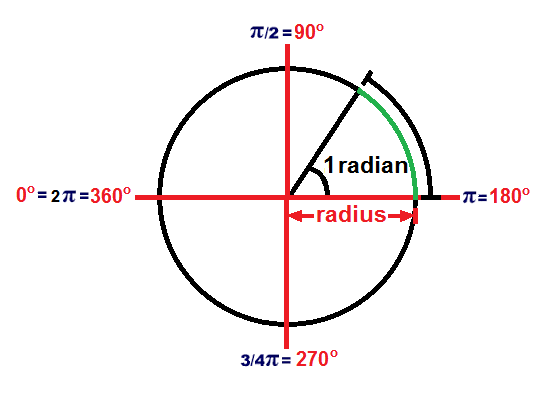
radial frequency – see angular frequency.
radian – a unit used to measure angles, equal to an angle at the center of a circle with an arc equal to the length of its radius. The magnitude in radians of one complete revolution (a circle or 360°) is the length of the circumference divided by the radius, or 2πr/r = 2π. Since 2π radians equals 360°, one radian is equal to 180/π degrees, or about 57.296°. Abbreviated as rad.
radian frequency – see angular frequency.
radiant energy – see electromagnetic energy.
radiant flux – see radiant power.
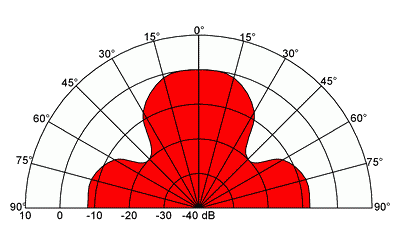
radiant power – the rate of flow of electromagnetic energy (radiant energy), usually expressed in watts (joules/second). Also called radiant flux or simply power. See also spectral power.
radiation – (1) The sound projected from a loudspeaker. (2) The emission of energy as electromagnetic waves.
radiation pattern – the angle and coverage of sound projected from a loudspeaker as indicated on a polar graph. A speaker with a wide directivity (also called wide or broad dispersion) maintains a consistent sound pressure level (SPL) for both the on-axis and off-axis sound. A speaker with a narrow directivity speaker (also called narrow dispersion) has on- and off-axis levels that are substantially different. Radiation patterns are frequency-dependent. When the wavelength is large relative to the size of the driver, the radiation pattern tends to be omnidirectional. As the wavelength becomes smaller relative to the driver size, the radiation beam begins to narrow. Therefore, as the frequency increases, the sound becomes more directional. Also called dispersion pattern, directivity, or directionality. See also dispersion angle.

radio – (1) The transmission and reception of electromagnetic waves in the radio frequencies, especially those carrying an audio signals. (2) The appliance used to receive audio transmissions via radio waves. Sometimes called a radio set, a radio receiver, or a wireless (an old British term). (3) Electromagnetic waves in the radio frequency range. (4) To communicate using radio transmissions. (5) The radio broadcast industry and/or the broadcast media.
Radio Broadcast Data System (RBDS) – see Radio Data System.
radio broadcasting – the transmission by radio frequency waves of program material for direct reception by the general public.
radio edit – a special mix that is used to make song more suitable for radio airplay. It may be adjusted for things, such as length, profanity, subject matter, or format. Often radio edits are used for the commercial single version of the song, but not always. Also called a radio mix.
radio mix – see radio edit.
radio receiver – see receiver.
Radio Data System (RDS) – a system for embedding small amounts of digital information in conventional FM radio broadcasts. The standard, originally started as a project of the EBU, has become an international standard of the IEC. The US version is officially designated at the Radio Broadcast Data System (RBDS) and is slightly different from the European version. RDS is capable of displaying station ID, traffic information, program information (PI), and genre. It also has the ability to lock onto best possible frequency for a stations with alternate frequencies (AF).
Radio Electronics Television Manufacturers (RETMA) – see Electronic Industries Alliance.
radio frequency (RF) – the frequency of radio waves, generally considered to be the range of about 30 Hz to 300 GHz.
radio frequency allocation – see frequency allocation.
radio frequency band – a specific range of frequencies in the radio-frequency spectrum, that is divided into several ranges from very low frequencies (VLF) to extremely high frequencies (EHF). See diagram at right and the radio frequency chart. Also called a frequency band or simply a band.
radio frequency interference (RFI) – interference caused by radio frequencies (RF) getting into audio equipment, typically from the broadcast of nearby radio and television stations.
radio-frequency spectrum (RFS) – that portion of the electromagnetic spectrum used for communications, which includes frequencies used for radio, radar, and television, and generally considered to be the range of about 30 Hz to 300 GHz. Because two radio transmitters using the same frequency band can cause mutual interference, usage of the radio spectrum is regulated by the International Telecommunication Union (ITU) and other governmental agencies for international users and by the Federal Communications Commission (FCC) for users in the US. Regulators assign each transmission source a frequency of operation, a transmitter radiation pattern, and a maximum transmitter power. See diagram at right and the radio frequency chart.
radio frequency wave – see radio wave.
Radio Manufacturers Association (RMA) – see Electronic Industries Alliance.
radio microphone – see wireless microphone.
radio network – see network, defintion #2.
radio receiver – (1) An electronic device that receives incoming modulated radio waves and converts them into sound or data. (2) A radio set. Sometimes called a wireless (an old British term). Called a radio for short.
radio signal – a radio wave used to transmit and receive messages.
radio spectrum – see radio-frequency spectrum.
radio station – an installation or organization used for the production and transmission of AM or FM radio broadcasts.
Radio Television Manufacturers Association (RTMA) – see Electronic Industries Alliance.
radio transmitter – see transmitter.
radio wave – an electromagnetic wave within the range of the radio frequency spectrum. Such a wave can be man-made, such as a transmissions from radio stations, or natural, such as emissions from lightning and sunspots.
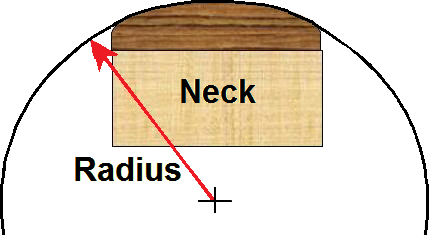
radius – the curvature of the fingerboard of guitars, mandolins, violins, and other string instruments across the neck from the high string to the low string, as if the fingerboard were cut from a solid round piece of wood of a given radius. See also camber.
rageo – see rasgueado.
RAI – Radio Audizioni Italiane. (1) Italy's national public broadcasting company, known since 1954 as Radiotelevisione Italiana, and now stylized as Rai. (2) A standard established by Rai for a stereo microphone technique that specifies two cardioid microphones 21 cm (8.3 inches) apart and angled at 100 degrees. It falls into the near-coincident pair category of techniques. Other techniques in this category include A-B, DIN, EBS, Faulkner array, NOS, ORTF. See also coincident pair (Blumlein array, mid-side, X-Y pair) and spaced pair (A-B, Decca tree, spaced cardiods, spaced omnis). See table comparing various stereo microphone techniques.
RAID (Redundant Array of Independent Disks) – a technology for storing data on multiple hard disks to protect data in the case of a drive failure, although not all versions provide redundancy. Data is distributed across several drives in one of several schemes, referred to as RAID levels. The different levels are designated RAID 0, RAID 1, RAID 2, etc. Each RAID level provides a different balance among the goals of reliability, availability, performance, and capacity. Originally named redundant array of inexpensive disks. See also NAS.
rail – see rack rail.
RAI technique – see RAI, definition #2.

rainstick – a percussion instrument originally from Chile made from a branch of a dried cactus that is hollowed out, filled with small pebbles, and capped at both ends. It makes the sound similar to falling rain when tilted slightly. The Chilean name is palo de lluvia. Also spelled rain stick.
rajeo – see rasgueado.
.ram – file extension for a file linking to a RealAudio file.
RAM – Random Access Memory. Michrochips used as computer memory to store data, including the instructions of a computer program. It is considered random access because the data does not need to be stored in any particular order.

ramp wave – a waveform similar to a sawtooth waveform except that it rises slowly from zero and then instantly drops back to zero to form one cycle. See also sawtooth wave, sine wave, square wave, and triangle wave.
random noise – (1) A random fluctuation in an electrical signal characteristic of all electronic circuits. There are a variety of sources and types of random noise, such as thermal noise and flicker noise. (2) A noise in which each frequency within an octave has an equal probability of occurring. See noise colors.
random incidence microphone – see microphone response types.
random note generator – a device in a synthesizer that creates unpredictable tones at a regular rate.
range – a control on a gate that specifies the amount of attenuation to be applied when the gate is closed. Sometimes called floor.
rare earth magnet – a strong permanent magnet made from alloys of rare earth elements (those with atomic number from 57 to 71). Rare earth elements are not all that rare, being commonly found in the earth's crust. They have high electrical conductivity and produce significantly stronger magnetic fields than other types of magnets, such as ferrite or alnico magnets. Because rare earth magnets are extremely brittle and susceptable to corrosion, they are usually plated or coated. The most common rare earth magnets are neodymium and samarium-cobalt.
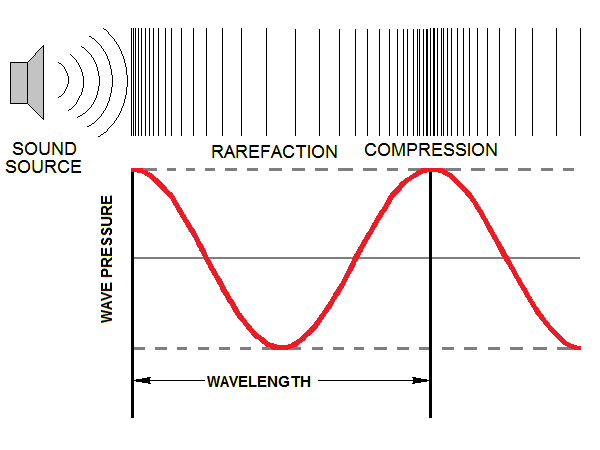
of Sound Waves
rarefaction – the portion of a sound wave in which air molecules are spread farther apart forming an area of lower pressure. The opposite of compression.
raspy – (1) A descriptive term for a harsh sound. (2) A descriptive term for vocals with excessive sibilance or with a piercing sound due to peaks in the 6 to 7 kHz range.
rasgueado – a guitar strumming technique commonly associated with flamenco guitar or classical guitar. It uses the fingers of the strumming hand in a rhythmically precise and often rapid strumming pattern, strumming the strings upwards with the fingernails or downwards with the fingertips. Also called rageo, rajeo, rasgueo, rasgeo, or rasqueado.
rasgeo – see rasgueado.
rasgueo – see rasgueado.
rasqueado – see rasgueado.
raster – (1) The scan pattern on a television set in which the electron beam of a cathode ray tube (CRT) scans lines from side to side and from top to bottom. (2) A pattern of closely spaced rows of dots that form an image (as on the cathode-ray tube of a television or computer display). (3) The electronic circuit that creates the scanning spot that traces the lines on the TV screen.
rate – the length of time during which the depth circuit of a delay program completes one full increase or decrease cycle for the nominal delay time, resulting in a vibrato sound.
rate control – a parameter on a synthesizer that controls the rate or timing of certain actions, such as the attack, decay and release portions of an ADSR envelope.
rated bandwidth – the frequency range (usually 20 Hz to 20 kHz) over which the performance of an audio device is evaluated with respect to rated specifications, such as power output, distortion, etc.
rated load impedance – the input impedance of a device when a load is present (another device or equipment is connected).
rated output – (1) The maximum output that can safely be handled by a component, circuit, device, or system. (2) The maximum output of a component, circuit, device, or system as established by the manufacturer.
raw – an audio file format used for storing audio in a raw form, that is, without a header or metadata. Data is usually written using PCM, but other codecs are sometimes used. It is mainly used for technical testing, but can be used with some audio players, but because there is no header, the user must input information, such as the type of encoding, the sample rate, the bitrate and othe data. Raw files use the extension .raw, .pcm, or none at all. Also called RAW Audio.
RBDS – Radio Broadcast Data System. See Radio Data System.
RC – (1) Resistor-Capacitor. (2) Remote Control. (3) Remote Collaboration. (3) Room Criteria.
RCA – Radio Corporation of America. A US electronics company in existence from 1919 to 1986 and later known as the RCA Corporation. GE took over RCA in 1986 and sold off various assets. It sold its interest in RCA Records to Bertelsmann, which became BMG Music (Bertlesmann Music Group). GE sold the GE and RCA brand rights for televisions and othe consumer electronics to Thomson Electronics of France.
RCA 44 – a bidirectional ribbon microphone developed by Dr. Harry F. Olson of RCA and introduced in 1931. The 44-A was RCA's first permanent magnet ribbon microphone. With the smooth sound of the ribbon and its attractive styling, it was well received by broadcasters well into the 1940s. Updates in design and improved magnet materials
resulted in the 44-B and 44-BX. It became a classic and remained in production until the mid 1950s.
RCA 77 – a unidirectional ribbon microphone developed by Dr. Harry F. Olson of RCA and introduced in the early 1930s as the RCA 77-A. It used double ribbons that combined a pressure unit with a velocity unit to achieve the unidirectional pattern. Improvements in magnet material resulted in a significant reduction in size with the 77-B. The 77-C and 77-D introduced multiple patterns. The 77-D and 77-DX were single-ribbon models produced after World War II, and remained in production until 1973 when RCA ceased production of all microphones.
RCA connector – see phono plug.
RCA jack – see phono jack.
RCA plug – see phono plug.
RCA Records – a recording label in the US. In 1929, Radio Corporation of America (RCA) purchased the Victor Talking Machine Company, then the world's largest manufacturer of phonograph records and phonographs (including the Victrola) and formed RCA Victor. It later became RCA Records. Today it is part of Sony Music Entertaiment.
RCA Victor – see RCA Records.
RCA-VOC – see VOC format.
RC circuit – Resistor-Capacitor circuit. An electric circuit composed of resistors and capacitors and a power source. The simplest RC circuit is composed of one resistor and one capacitor and is called a first-order RC circuit. RC circuits are used to filter a signal by blocking some frequencies and passing others, such as high-pass filters and low-pass filters. Sometimes called an RC filter or RC network.
RCD – Residual-Current Device.
RC filter – see RC circuit.
RC network – see RC circuit.
RC time constant – see time constant.
RCV – abbreviation for receive or receiver.
RCVR – abbreviation for receiver.
R-DAT – see DAT and DASH.
RDS – Radio Data System.
RE20 – see Electro-Voice RE20.
reach – the distance from which a microphone can pick up a sound signal without significant interference from noise.
reactance (X) – the opposition in a circuit element to a change of electric current or voltage, due to inductance or capacitance, which changes with the frequency of the current, measured in ohms.
reactive load – see load, definition #2.
reactive power – see apparent power.
reactive silencer – see silencer.
read head – the device that pickups magnetic signals on a storage medium, such a hard disk, and converts it into digital data.
RealAudio – a proprietary audio file format designed by RealNetworks for streaming audio over the internet. It uses a variety of codecs, ranging from low-bitrate formats for use with dialup modems to high-fidelity formats suitable for music. Although it was once widely used by many internet radio stations for streaming music, RealAudio has lost out to other formats that have become more popular. It uses the .ra file extension. A file using the .ram extension is a text file with a link to an internet address where a RealAudio file can be found. It does not contain any audio data.
Real Sound Lab SIA – a company headquartered in Tokyo, Japan, that makes audio software and hardware.
real stereo – see true stereo.
real time – occurring at the actual time something takes place and in the actual time frame, as opposed to occurring at some later time or in a faster or slower speed.
real-time analyzer (RTA) – a spectrum analyzer that measures and displays a graph of the amplitude of an audio signal at various frequency bands in real time. An RTA is frequently used to correct the frequency response of a room or monitoring system.
real-time dubbing – duplicating a recording tape at its normal playing speed, which results in higher quality than a high-speed dubbing.
real-time input – MIDI data that is input as it is being played, such as during a performance or a studio recording session, as opposed to a step input.
re-amp – the process of running a recorded signal (such as a DI guitar) back through an amplifier and speaker to obtain the sound or effect of the amp/speaker system. Although done originally with guitars, the process has expanded to many types of instruments. Short for re-amplify. Although sometimes spelled without the hyphen, care must be exercised as Reamp® is a trademark of the Reamp Company.
Reamp Company – a company located in Oakland, CA, founded by John Cuniberti in 1994 that designed and built Reamp®, a device that provided the ability to feed a previously recorded guitar track back into an amplifier to be re-recorded. Reamp was purchased by Radial Engineering in 2012.
re-amplify – see re-amp.
rear bus compression – a multi-stage compression technique developed by mix engineer Andrew Sheps. So-called because he originally used the rear bus of the Neve 8088 console. This technique varies, but typically sends all tracks except drums to a stereo aux bus with a 1176-style compressor in multi-mono (unlinked stereo) with a low ratio, slow attacks, and fast release. Compression is still used on the mix bus (therefore making the technique multi-stage). The effect is designed to make the sound more energetic and punchy.
rear surround speakers – one or two loudspeakers placed behind the listening position in 6.1-channel or higher surround theater systems. Also called rear speakers or back surround speakers.
REAPER – Rapid Environment for Audio Production, Engineering, and Recording. A digital audio workstation developed by by Cockos.
Reason – a computer program for creating and editing music developed by the Swedish company Propellerhead Software, that emulates a rack of hardware synthesizers, samplers, signal processors, sequencers, mixers, and other devices that can be freely and abitrarily interconnected.
reassign – to re-route or designate an alternate output bus for a given bus or output in a console or DAW.
rebroadcaster – see broadcast translator.
recapping – replacing the capacitors in audio equipment either because they are beginning to fail or to improve audio quality. Electrolytic capacitors especially are prone to dry out and deteriorate with age. Also called shotgunning.
REC – (1) One of several abbreviations for receive. (2) Abbreviation for record.
recce – to visit a location ahead of time to determine the suitability for recording, filmmaking, and/or videoing, to avoid any potential sound or lighting issues. The term is used in media, radio, and TV production primarily in the UK, Australia, New Zealand, and South Africa, and is a term borrowed from the miltiary, derived from reconnaissance or reconnoiter. In the US the term site survey is more commonly used.
receive – (1) To pick up or detect radio signals and convert them into other forms, such as audio or video. Abbreviated as REC, RCV, or RX. (2) To acquire sound, such as a microphone acquring a sound wave.
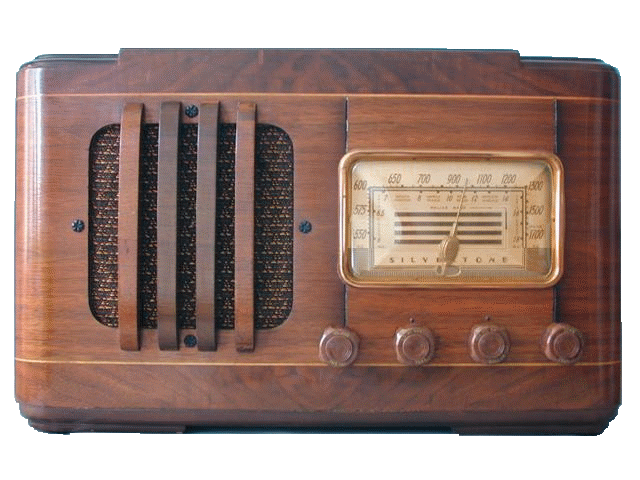
receiver – (1) A device that picks up incoming radio signals and converts them into other forms, such as audio or video. Sometimes called a radio receiver. Abbreviated as RCV or RCVR. (2) Short for AV receiver.
receiving angle – see axis angle.
receptacle – a jack or outlet into which a plug or other input device can be inserted. See male connector and female connector.
reception – (1) The process of picking up radio signals and converting them into other forms, such as audio or video. (2) A message or broadcast that is received using radio waves.
recirculation – see regeneration.
reclock – to align bars and beats of music recorded without a click track or tempo reference in a DAW.
reconstruction filter – see anti-imaging filter.
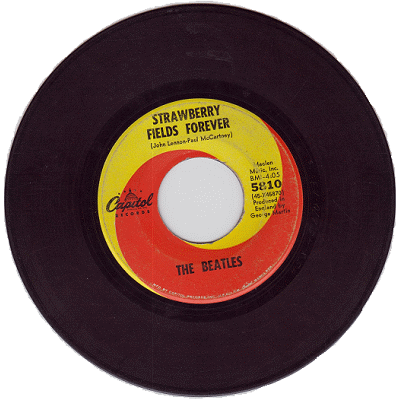
record – (1) To store data or audio signals in an analog or digital format for subsequent reproduction or broadcast, such as magnetic signals on magnetic tape, digital data on a hard disk drive, or optical data on an optical disk. (2) A flat disc usually made of vinyl onto which grooves have been placed that reproduces music or other audio. Sometimes called a phonograph record or gramophone record. (3) Any recorded media.
Record – a digital audio workstation developed by Swedish software developers Propellerhead Software. Record can be used by itself or along with Propellerhead's Reason.
record company – see record label.
record deal – slang for a recording contract.
recorded music history – the history of audio recording is generally broken down into four parts:
• acoustic era - 1890 to 1925
• electrical era - 1925 to 1947
• magnetic tape era - 1947 to 1982
• digital era - 1982 to present
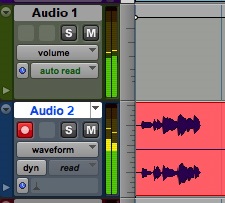
is record enabled,
but track “Audio 1” is not.
While the precise years varies slightly by source, they are fairly close to those shown above. Some historians call the magnetic tape era the high-fidleity era, and some break it down further into the monaural era and the stereo era. For more details, see The History of Audio Recording.
record enable – to place a track or channel on a recording device into the state of being ready to record. When the device is in record mode and the start (play) button is pressed, only record-enabled tracks will record audio (usually while monitoring the input audio), while non-enabled tracks normally play previously recorded audio (if any). Also called track armed.
record equalization – an equalization curve applied during recording of a recording tape that will be compensated for during playback with playback equalization in order to minimize tape noise. Also called pre-emphasis. See also CCIR curve and NAB curve.
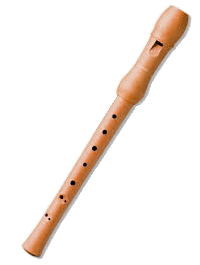
(Instrument)
recorder – (1) Any machine, device, or software that can be used to record audio signals, including tape machines, cassette decks, wire recorders, portable studios, and digital audio workstations (DAW). (2) A person who makes a sound recording, but more often the term recordist is used as the term recorder usually refers to a recording machine. (3) An end-blown flute-like musical instrument in the fipple flute family. It is usually made of wood with the mouthpiece (fipple) one piece with the body. It has seven finger holes on the top (the lower two often doubled to produce semitones) and one for the thumb of the upper hand.
Recorderman technique – a drum miking technique somewhat similar to the Glyn Johns technique, but using two microphones instead of four. It consists of one cardioid microphone suspended about 32 inches above the center of the snare drum, pointing straight down. A second cardioid mic is positioned near the drummer's right shoulder, pointing directly at the snare drum also about 32 inches away. The kick drum should be equidistant from both microphones. The two tracks are panned left and right about 70% to 80%. The technique comes from a person using the user name Recorderman on one of the recording forums who is credited with popularizing the technique.
recorder-mixer – see portable studio.
record head – the head on a tape recorder that places a magnetic signal on recording tape in response to audio signals. See tape machine for diagram.
recording – (1) The process of storing data, video, or audio signals in an analog or digital format for subsequent reproduction or broadcast. (2) Data, video, or audio that has been stored in an analog or digital format. (3) A recorded broadcast or performance. (4) A disc or tape on which sounds or visual images have been recorded. (5) The industry consisting of recording studios, producers, record labels, distributors, and others involved with audio recordings. See also sound recording and tape recording.
Recording Academy, The – an organization of professionals in the recording business such as musicians, producers, recording engineers, and others. The Recording Academy is probably best known for the annual Grammy Awards. It was formerly known as the National Academy of Recording Arts & Science (NARAS).
recording angle – see stereo recording angle.
recording chain – see signal chain.
recording contract – a legal agreement between a record label and a recording artist or group. The details of recording contracts vary with the artist, but typically the artist agrees to record a song or series of songs for the label, which the label sells and promotes, in return for a payment or a share in the royalties. Artists usually are restricted to record for that label exclusively. Also called a record deal.
recording device – see recorder.
recording engineer – a specialist skilled in the use and techniques of recording, mixing, reproducing, and amplifying sounds, whether live or in the studio. Also called an audio engineer, audio technician, audio technologist, sound engineer, sound operator, or sound technician. Although these terms are often used interchangeably, they can mean different things depending on the context. Compare with audio engineer, studio engineer, or sound engineer.
recording field – the magnetic field produced by a record head when electric current is applied, measured in amperes per meter (A/m), which is equal to about 0.0012566 oersteds (Oe).
recording format – a method of encoding data (whether it be data, music, or video) onto a recording medium in such a way that it can be read and correctly interpreted by the hardware.
recording head – see record head.
recording industry – the portion of the music industry that records music and sells the recordings to the public. Among others, it includes recording studios, engineers, producers, publishers, record labels, retail record stores, and performance rights organizations. It is sometimes used loosely as a synomym for the music industry.
Recording Industry Association of America (RIAA) – an organization within the recording industry that establishes standards for the industry and works to protect its intellectual property rights.
recording level – (1) The intensity of a signal going into a tape machine, DAW. or other recorder. (2) The control that regulates the intensity of a signal being recorded. Also called record level.
recording medium – the physical material used to store recordings, including music and data. The three primary types of media are the mechanical (phonograph records), optical (CDs, DVDs, and digital motion-picture sound tracks), and magnetic (recording tape and hard disks). Plural is recording media. See also medium, definition #3.
recording programs – see audio recording software.
recording rights – see master rights.
recording session – a period of time in which music is recorded in a studio.
recording software – see audio recording software.
recording solo – a switch that turns on the audio from one channel while muting all remaining channels.
recording studio – a facility for making audio recordings. A recording studio usually consists of at least two rooms: (1) the studio or live room, where music, dialog, and other sounds are created, and (2) the control room, where the audio from the studio is recorded and processed. A well-designed studio will have good acoustics and a high degree of sound isolation between rooms and the outside world.
recording tape – see magnetic recording tape.
recording tuba – see tuba.
recordist – (1) A person who makes a sound recording. Also called a recording engineer. Sometimes called a recorder, but that term more often refers to a recording machine. (2) The person who controls a tape machine. Also called a tape operator. (3) The person on a film set in charge of sound recording. Also called sound recordist.
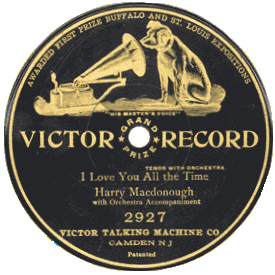
record label – (1) A round paper disc (label) in the center of a phonograph record that provides the title, artist, manufacturer, and other information about the record. (2) A distinctive brand used by a record company to market its catalog of music. (3) The record company itself. A record label coordinates the production, manufacture, distribution, marketing, and promotion of sound recordings, seeks out and develops new talent (A&R), and manages contracts with recording artists. Sometimes a label also operates a publishing company that manages and enforces the copyright of music. The term record label comes from the label in definition #1 above. Also called a record company.
record level – see recording level.
record mode – the configuartion of a recording device when it is set to record audio once the start (play) button is pressed. Only record-enabled tracks will record audio, while non-enabled tracks normally play previously recorded audio (if any). The recorded tracks can be listened to later using the playback mode.
record player – see phonograph or gramophone.
record producer – see producer.
rectifier – an electrical device that converts an alternating current (ac) into a direct current (dc) by allowing the current to flow in only one direction. Rectifiers can use vacuum tubes or they can be solid state. Some claim that because solid-state rectifiers have no internal resistance, they provide a more detailed and punchier sound than tube-type rectifiers.
rectify – to convert an alternating current (ac) into a direct current (dc) by allowing the current to flow in only one direction.
recursive equation – an equation in which the result of one calculation is used to make future calculations. They are often used to make filter and equalization calculations in digital implementations, because they speed up the computations. A filter that uses a recursive equation is known as a recursive filter. Also called a recursive formula.
recursive filter – see recursive equation.
recursive formula – see recursive equation.
Red Book – specifications developed by Philips and Sony for the storage of audio on a compact disc. See also Blue Book, Yellow Book, White Book, Green Book, and Orange Book.
red noise – a random noise in which the energy content decreases at 6 dB per octave, thereby having most of its energy in the low frequencies. Also called brown noise or Brownian noise after Robert Brown. See noise colors.
red-light syndrome – a slang term for the condition in which a performer becomes nervous or gets stage fright when the recording button is pushed and the “red light” comes on.
reed – a thin strip of material used on some musical instruments that vibrates when air passes over it to produce a sound. The reeds of most woodwind instruments are made from the giant cane plant while tuned reeds used in harmonicas and accordions are made of metal or synthetic materials.
reedy – a descriptive term for a sound that is high-pitched, thin, and weak.
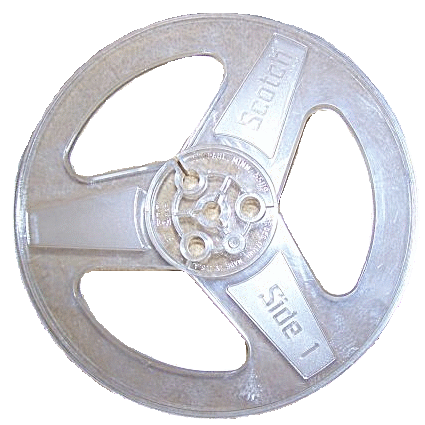
reel – (1) The spool onto which magnetic recording tape is wound. Reels come in diameters of 3 inches, 5 inches, 7 inches, 10½ inches, and 14 inches for use with various size tapes. (See magnetic recording tape for information on tape widths.) (2) The spool onto which movie film is wound. Originally a standard 35-mm film reel was 1,000 feet (305 m), which ran approximately 11 minutes. Today a standard reel is 2,000 feet (610 m). See also film footage. (3) The amount of magnetic tape or movie film that fits on one reel.
reel lock – a device that secures a tape reel to the tape platter (turntable) on a tape machine.
reel motor – the motor that turns the tape platter (turntable) holding the reel on a tape machine.
reel size control – the control on a tape machine that maintains proper tape tension by adjusting for various sizes supply reels and take-up reels.
reel-to-reel – see open reel.
reference frequency – see test tone.
reference level – (1) The level used as a basis of comparison when designating the level of an audio signal, usually measured in decibels or volume units. Also known as a reference signal level. (2) The power level used as a reference when calculating ratios for decibels. Also called a reference point.
reference point – see reference level, definition #2.
reference monitors – see studio monitors.
reference signal level – see reference level, definition #1.
reference source – the master clock generator that provides the clock signal used to synchronize timing. It can be an internal crystal sync, a video sync, an ac power pulse, or an external tone.
reference tape – see alignment tape.
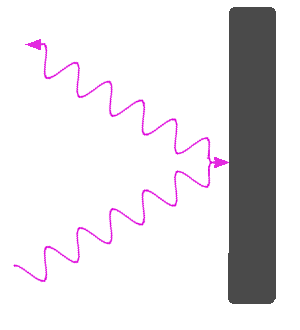
reference track – a track on a commercially-released compact disc used for comparison when mixing. The goal is not to copy the sound, but to match the frequency response, dynamics, feel, and energy of the reference track. The reference track should be in the same style as the track being mixed.
reference tone – see test tone.
reference vocal – see scratch vocal.
reflected sound – see reflection.
reflection – a sound wave that arrives at a microphone or listener after bouncing off a surface, such as a wall. Also called acoustic reflection, reflected sound, or indirect sound. See also initial reflection and specular reflection.
reflection filter – see reflection shield.
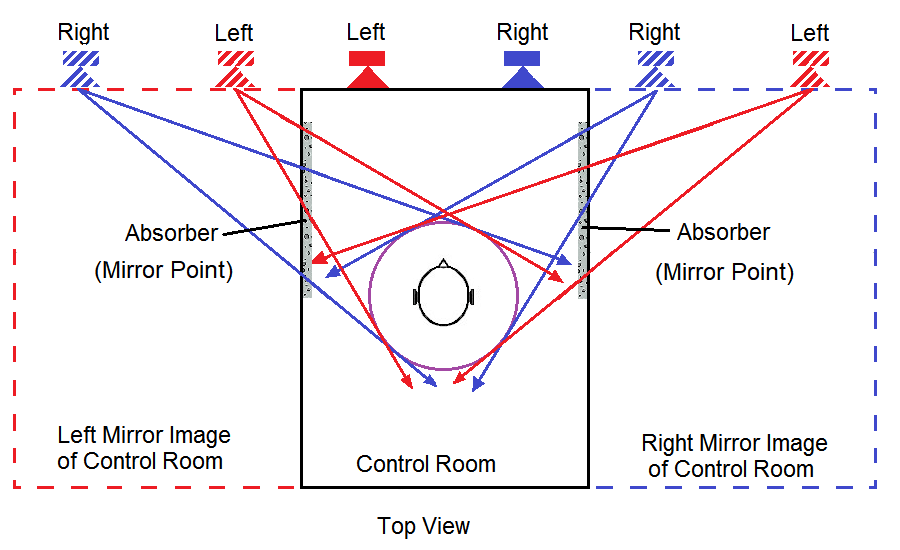
reflection-free zone (RFZ) – (1) A control room design that minimizes sound wave reflections so that they impose minimal character on the sound in the listening area. This is accomplished by imagining a mirror on each side wall. Absorbers are placed on those walls to obscure the “view” (mirror points) of the monitors. (See diagram.) The term was coined by Peter D'Antonio of RPG Diffusor Systems, Inc. Compare with LEDE, ESS, non-environment, and controlled image designs. (2) The spot in a control room where there are no reflections, having been minimized by a control room design.
reflection phase grating (RPG) – a sound diffuser designed by RPG Diffusor Systems based on the concept of a diffraction grating that diffuses sound waves more evenly and over a wider frequency range than conventional diffusers.
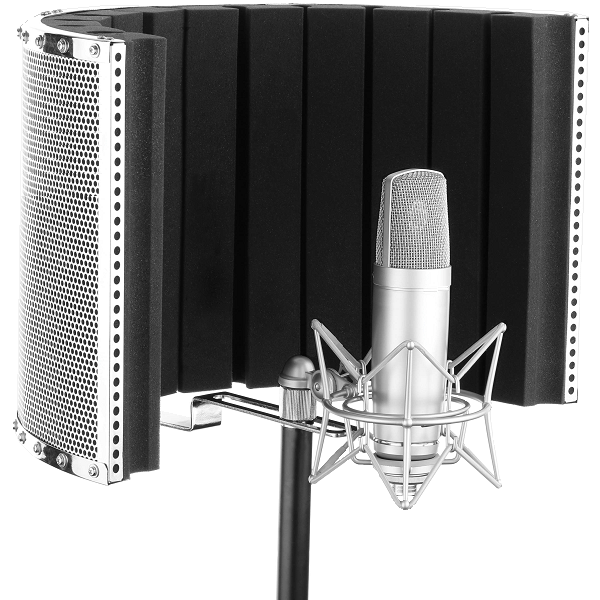
reflection shield – a semi-circular device made of acoustic-absorbing material that attaches to a microphone stand and surrounds the microphone in order to block or absorb sound waves preventing them from reflecting off nearby walls. It is designed to be used in rooms with insufficient acoustic treatment. Although some experts say they are helpful, others say they provide minimal improvement, since most of the reflections reaching the microphone come from behind the vocalist. Also known as isolation shield, sound shield, vocal shield, or reflection filter.
reflective silencer – see silencer.
reflector – a material such a hard surface off of which a sound wave will be bounced rather than absorbed. See also acoustic treatment.
reflex port – see ported speaker.
refraction – the splitting of a sound wave into various frequency bands as it passes from one medium into another, such as from air into water, similar to the way a prism disperses light into the colors of the rainbow.
refrain – see chorus, definition #1.
refresh rate – the rate at which a video display image is refreshed, usually expressed in hertz (Hz) or frames per second (fps). A higher refesh rates produces a smoother image. In countries with a power line frequency of 60 Hz, the refresh rate is 24, 30, or a multiple of 60. In countries with a 50-Hz power frequency, the refresh rate will be 25 or a multiple of 50. See also frame rate and field rate.
regenerating timecode – a timecode that is created by reading the code from the master tape and creating a perfect electronic duplicate of it when copying a video or audio tape that has a SMPTE timecode. The new code is created by an external device and is necessary to ensure that the copy is free of timing errors and dropouts.
regeneration – (1) Feeding the ouput from a delay device back into the input creating multiple echoes. (2) The control on a delay device that determines the amount of signal fed back to the input. Also called feedback or recirculation.
region – (1) A section of audio. An audio clip. (2) In REAPER a location similar to a marker that is used to identify a section of a song (such as intro, verse, or chorus), but unlike markers, regions have both a beginning and ending point for each section and are displayed in the regions band of the timeline. Markers are displayed in the marker ribbon.
regions band – see region, definition #2.
register – (1) The range of pitches of a voice or instrument. See also tessitura. (2) A set of pipes of one length on an organ, responsible for a specific octave or timbre.
registered jacks – a standardized network interface specifying both the type of connector and the wiring configuaration used in telecommunications and data equipment. Most registered jacks use the modular connector, but other connector types are used. The configurations are denoted by their RJ designations. See also RJ11, RJ12, and RJ45. For a list of RJ numbers and their configurations, see Wikipedia: Registered jack.
registered trademark – see trademark.
regulated power supply – a circuit that converts ac power into dc power to supply a stable voltage to a circuit or electronic device.
reinforcement – short for phase reinforcement.
rejection filter – see bandstop filter.
rejection node – see angle of maximum rejection.
relap – to do a very fine grain sanding or polishing on a tape recorder head to restore it to good working condition after it has been worn down.
relative grid mode – an editing mode in a DAW that allows movement and alignment of clips to specific points along a grid with user-defined increments while allowing the clips to maintain an offset relative to the grid point. See also absolute grid mode.
relative measurement – the measurement of a change or difference in a quantity or in relation to another item or device. For example, the gain of an amplifier is the change in voltage from the input to output. In contract, an absolute measurement is the measurement of a quantitiy starting from zero or a known starting point. For example, the measurment of a voltage is the number of volts above zero volts, while the height of a building is the distance from street level (the starting point) to the top of the building.
relative pitch – see absolute pitch.
relay – an electrical device that sends a current or signal in one circuit to an electromagnet to activate (open or close) another circuit.
relay station – (1) An amplifier for restoring the strength of a transmitted signal. (2) A broadcast translator.
relay transmitter – see broadcast translator.
release – (1) The amount of time it takes for a sound to go from the sustain level back to silence. The fourth of the four segments of an ADSR envelope. (2) The time it takes for the gain of a compressor to return to normal after the signal drops below the threshold. Also called release time. (3) To introduce a recording and make it available to the public for sale, such as a CD release.
release print – a copy of a film that is distributed to a movie theaters for exhibition. Sometimes called a film print.
release time – see release.
reluctance – the opposition to flow of a magnetic field.
remanence (Bd) – the amount of magnetization left behind in a ferromagnetic material after an external magnetic field is removed, measured in amperes per meter (A/m), which is equal to approximately 0.0012566 oersteds (Oe). The term remanence was once applied to magnetic recording tape, but the term has been deprecated in favor of residual flux density. Also called remanent flux or remanent magnetization. See also retentivity.
remanent flux – see remanence.
remanent magnetization – see remanence.
remediation – the act of stopping or reversing damage to recording media caused by environmental conditions, such as sticky-shed syndrome, adhesion, and shedding. Remediation is often required before archiving audio from older media.
REMI – REMote Integfration.
remix – (1) To mix a previously mixed song to create a variant version, sometimes adding additional tracks or samples. (2) A new version of a song that has been remixed. (3)(Rarely used) To mix or mixdown, i. e. combining several tracks into one stereo track.
remote – (1) A recording session that takes place outside the studio. See remote recording. (2) Activated without using the control panel on a device, as in remote control. (3) Controlled from a distance using a keypad, a transmitter, or other device.(4) A device used to control from a distance the operation of an appliance or machine, such as a television set or DVD player. Also called a remote control.
remote audio collaboration – see remote collaboration.
remote collaboration (RC) – two or more people working together on a recording project, either in real time (using remote music collaboration software) or offline using online file-sharing sites. Some DAWs have remote collaboration capabilities built in. For real-time collaboration, it recommended that you have internet speeds of at least 20 Mbps download and 10 Mbps upload. Also called cloud audio collaboration, online audio production collaboration, remote audio collaboration, or cloud-based session sharing.
remote control (RC) – (1) The control of the operation or performance of a device from a distance, such as controlling a DAW from a smart phone. (2) A device used to control from a distance the operation of an appliance or machine, such as a television set or DVD player. Also called a remote.
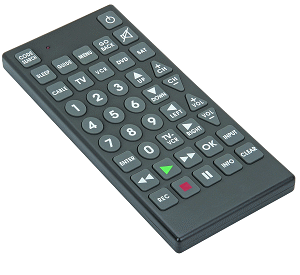
remote integration(REMI) – a television production model which uses automation, remote cameras (especially PTZ cameras), and other devicess to capture sporting events and other programs at a remote location, but that is mixed and controlled in the broadcast studio.
remote music collaboration software (RMCS) – software that allows two or more people to work together on a recording project in real time. See also remote collaboration.
remote musician – see remote session player.
remote recording – (1) A recording made outside the recording studio, such as recording a live performance at a concert. Also called on-location recording. (2) Recording parts of a project in another studio, using another engineer and one or more musicians (remote musicians), often using remote collaboration or by using a file-sharing site.
remote session musician – see remote session player.
remote session player – a musician or vocalist who provides musical tracks, usually for a fee, typically using remote collaboration or online file-sharing sites. Also called a remote session musician or remote musician.
render – (1) To change an audio file in a non-realtime process by applying the attributes defined in a plug-in or software program. This method is in contrast to a realtime procedure in which the attributes are applied to the audio file as it is being played without changing the file. (2) To consolidate several clips on a track into a single contiguous file. Other DAWs refer to this as consolidate, merge, or glue.
repeat – (1) A section of music that is to be played more than once, as indicated by a repeat mark. (2) In a delay effect, a single discrete echo or repetition of the sound.
repeat echo – an echo effect with discrete repeats of the sound. It is created using a delay unit with a long delay time and feedback. Sometimes called a space echo.
repeater – see broadcast translator.

repeat mark – a musical symbol consisting of two vertical lines preceded by two dots, one over the other, that indicates that the section is to be repeated, either from the beginning of the piece or from the beginning repeat mark. Also called repeat sign.
repertoire – (1) Music which a musician or musical group knows and is performance-ready. (2) The catalog of songs or performers that a publisher or record label has on its roster.
replace edit – a digital audio edit in which new audio material is pasted into a track to replace the existing audio material. See also three-point edit and four-point edit.
replacement dialog – dialog recorded after a film or video has been shot to replace poorly recorded sound or to change the dialog. See also ADR.
replay head – see playback head.
replication – a method of manufacturing compact discs in which a glass master is created from which multiple copies can be stamped. The stamper presses the pits (representing the data) into a polycarbonate disc onto which a reflective layer of an aluminum alloy is fixed. The entire disc is then coated with a lacquer. The finished product is an audio CD (not a CD-R) just like you buy in the record stores. This process is used for large quantities (typically 300 to 500 copies or more), as opposed to duplication, which is used for smaller quantities.
replicator – a company that manufactures compact discs, DVDs, and/or Blu-ray discs using the process of replication.
reprocessed stereo – see simulated stereo.
reproduce – (1) To create music or other audio from a recording or other storage device. (2) To playback audio that has been previously recorded. (3) To make one or more copies of a recording, file, or other item.
reproduce mode – see playback mode.
reproduction – (1) The process of creating music or other audio from a recording or other storage device. (2) Playing back audio that has been previously recorded. (3) The process of making one or more copies of a recording, file, or other item.
reproduction head – see playback head.
reproduction rights – see master rights.
repro head – Short for reproduction head. See playback head.
re-recording – the process in which the dialog, dialog replacement, sound effects, music, and other sounds are mixed together to form the final soundtrack for a movie. Also called dubbing.
re-recording engineer – the person who carries out the process of re-recording of a movie soundtrack. Also called a re-reording mixer and formerly called a dubbing mixer.
re-recording mixer – see re-recording engineer.
re-recording stage – see dub stage.
re-recording studio – see dub stage.
residual-current device (RCD) – a British term for a device designed to protect from electrical shock by tripping a circuit breaker when a difference in current occurs between the “hot” and neutral wires, indicating a short or abnormal diversion of current. In the US it is called a ground fault circuit interrupter (GFCI) or a ground fault interrupter (GFI).
residual flux density (Br) – the amount of magnetism left in a magnetic medium after an applied magnetic field is removed, measured in teslas (T), which is equivalent to webers per square meter (Wb/m2). Also called residual induction, residual magnetization, or residual magnetism. See also retentivity and remanence.
residual induction – see residual flux density.
residual magnetism – see residual flux density.
residual magnetization – see residual flux density.
residual noise – the noise left on a magnetic recording tape after it has been erased.
resistance (R) – the opposition to the flow of a direct current in a circuit, as measured in ohms. The relationship between the voltage (V), resistance (R), and current (I) is V = IR, which is known as Ohm's Law.
resistive absorber – see porous absorber.
resistive load – see load, definition #2.
resistive opto-isolator (RO) – an optoelectronic device consisting of a light source and detector, that are optically coupled and electrically isolated from one another. The light source is usually a light-emitting diode (LED), incandescent lamp, or neon lamp, and the detector is a photocell. The RO acts like a variable resistor that is controlled by the current flowing through the light source. ROs are used in some audio equipment, guitar amplifiers, and analog synthesizers because of their good electrical isolation, low signal distortion, and ease of circuit design. Also called a photoresistive opto-isolator, analog opto-isolator, or lamp-coupled photocell.
resistivity – the property of a given material that indicates how strongly it opposes the flow of electric current. It is the reciprocal of electrical conductivity. Resistivity is represented by the Greek letter ρ (rho). The SI unit of resistivity is the ohm-meter (Ω-m), but the ohm-centimeter (Ω-cm) is sometimes used. Resistance (R) can be calculated for a material using the equation R = ρ × L/A, where ρ is resistivity, L is the length, and A is the cross-sectional area. Also called electrical resistivity, specific resistance, or volume resistivity.

resistor – an electronic component that resists direct current in a circuit.
resolution – (1) A measure of the detail or fineness of a system or device. In film photography, resolution (called image resolution) is usually expressed in lines per inch. In digital photography, resolution is often expressed in megapixels, the total number of pixels in the image. For a digital television screen, computer monitor, or other display device, resolution (called display resolution or graphic display resolution) is usually expressed as the number of pixels in each direction, such as 1920 × 1080. Printers express resolution (called print resolution or printing resolution) as the number of individual dots that a printer can produce within a unit distance, such as dots per inch (dpi). For digital audio, resolution is measured by bit depth, the number of bits used to express amplitude in sampled audio. However, resolution can also be expressed in the time domain. A CD with a sample rate of 44.1 kHz has a resolution of 1/44,100 or about 0.023 milliseconds. (2) In music, the movement of a note or chord from dissonance (an unstable sound) to a consonance (a more final or stable sounding one).
resonance – (1) The prolonged vibration at a certain frequency, such as a bell. (2) The tendency of an object to vibrate with a greater intensity at a particular frequency, called its natural frequency or resonant frequency. (3) The parameter on a filter that controls the width of the frequency band around the center frequency. Also called quality factor (Q).
resonance pads – see damper pads.
resonant – (1) Tending to vibrate or oscillate at a particular frequency when excited by an external source and to continue to vibrate after the excitation is removed. (2) A descriptive term for a sound that is deep and clear, especially used when describing a voice. (3) A descriptive term for a sound that continues to ring or linger.
resonant absorber – a type of sound absorber that is designed to absorb sound energy of a specific range of frequencies, typically using a resonance mechanism such as an enclosed air volume (such as a Helmholtz resonator). Panel absorbers (membrane absorbers), which have a resonance mechanism (vibrating surface), are sometimes grouped with resonant absorbers. Resonant absorbers are used mainly to absorb sounds in the mid to low frequencies. See also porous absorber, panel absorber, and acoustic treatment.
resonant circuit – see LC circuit.
resonant frequency (ω) – the frequency at which an object tends to vibrate with a greater intensity than at other frequencies. Also called natural frequency. See also resonance.
resonant head – the head on the side of the drum that is not struck by the drummer, designed to enhance the tone of the drum when the batter head on the opposite side of the drum is struck. Resonant heads are typically used on snare drums, but toms and kick drums may or may not have them.
resonate – (1) To vibrate at the resonant frequency. (2) To reverberate for a while. To have a sound linger on.
resonator – (1) A resonant absorber. (2) A device that increases the resonance of a sound, especially the hollow part of a musical instrument. (3) Tubes made of metal or wood and mounted below the bars of xylophones, marimbas, and vibraphones to enhance the tone.
resonator effect – an audio effect or device that takes an incoming signal and feeds it through a series of delay lines that are then fed back into themselves so that they begin to ring, or oscillate, creating a series of tonal harmonics that are superimposed onto the incoming signal. This creates dynamic effects that react with more or less intensity based on the harmonic content of the input audio.
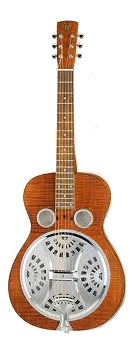
resonator guitar – an acoustic guitar that enhances the sound by resonating the string vibrations using one or more spun metal cones. Resonator guitars were originally created to be louder than regular acoustic guitars, which were hard to hear in dance orchestras that had horns and percussion. Even after amplified guitars solved this problem, they continued to be used because of their unique sound, especially in blues and bluegrass music. There are two main styles of resonator guitars: (a) square-necked guitars played like lap steel guitars and (b) round-necked guitars played like conventional acoustic guitars. There are three main resonator designs: (a) the tricone, having three metal cones, designed by the National String Instrument Corporation, (b) the single cone "biscuit" design also by National, and (c) the single inverted-cone design (called a “spider bridge”) by Dobro. Resonator guitars are often played using metalbars or slides (“bottlenecks”) made of metal, glass, or ceramic. Also called a resophonic guitar.
resophonic guitar – see resonator guitar.
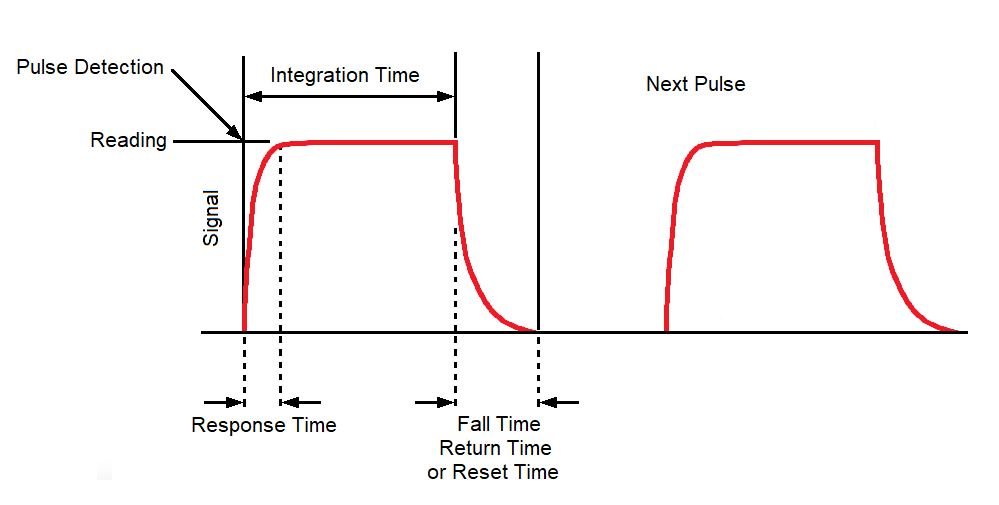
response – (1) The ability of a microphone to react to a sound of a particular level and frequency. (2) Short for frequency response.
response pattern – the same thing as a pick up pattern.
response time – in signal measurement, the amount of time it takes to reach 99% of the level of the signal. See also integration time and return time.
rest – a period of silence in a piece of music, indicated by a symbol denoting the length of the pause. Each rest symbol corresponds to a particular note value. For example, a half rest is the same length as a half note, a quarter rest is as long as a quarter note, etc.
resultant tone – see difference tone.

retentivity (Brs) – the flux density on a magnetic recording tape after a magnetic field of saturation strength is removed—the maximum flux density the tape can attain. See also residual flux density, saturation flux density, and remanence.
RETMA – Radio Electronics Television Manufacturers. See Electronic Industries Alliance.
return – the signal path on a mixer, console, or DAW coming back from signal processors, outboard devices, plug-ins, or other line-level inputs. A send is used to feed the device and a return is used to return the signal from the device, creating an effects loop. Also called auxiliary return, aux return, echo return, echo receive, or effects return. (2) To route an audio signal back from a processor, effects device, or plug-in to a console, mixer, or DAW.

return time – in signal measurement, the amount of time it takes to return to the starting point of the signal, usually zero (0) or in the case of an audio signal measured in dBFS, to -∞. Also called fall time or reset time. See also response time and integration time.
return to zero (RTZ) – (1) The function on a tape recorder that rewinds the recording tape back to the zero position on the tape counter. (2) A function on a digital audio workstation that takes the pointer to the beginning of a track.
Reussen shield – see double-spiral shield.
reverb – short for reverberation.
reverb density – see density, definition #1.
reverb diffusion – see diffusion, definition #2.
reverb drip – a very heavy reverberation often used with surf guitar music, played in a stacatto style with a very fast reverb that almost sounds like a delay. Reverb drip was originally produced using standalone Fender reverb tank and then later as part of their amplifiers.
reverberance – having the character or quality of being resonant or having many reverberations and echoes.
reverberant – having a sound with many reverberations and echoes. The opposite of dry.
reverberant field – the area at some distance from the sound source where reverberation is louder than the direct sound.
reverberberant tail – see late reflections.
reverberate – (1) To have many echoes. (2) To be reflected many times, such as sound waves bouncing from the walls of a confined space.
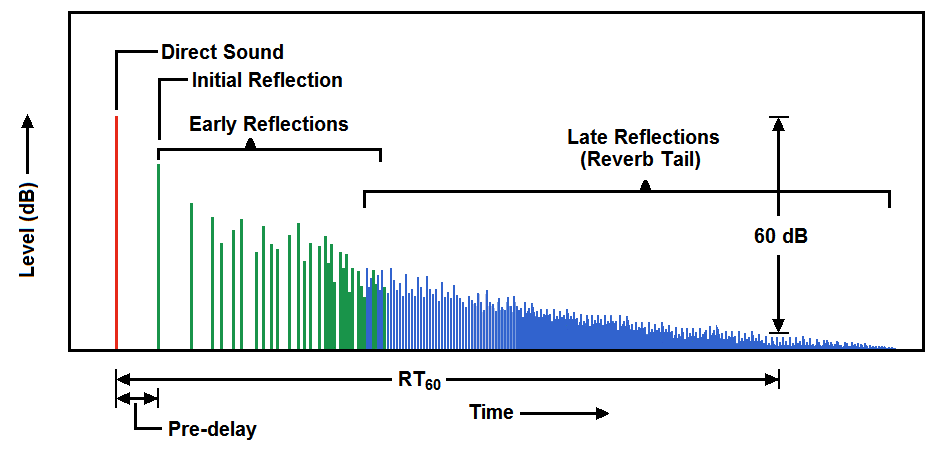
reverberation – the decaying residual sound that remains after a sound occurs, created by reflections of the sound wave bouncing off surfaces and other non-absorptive barriers (such as walls) within the acoustical environment. Reverberation can be broken into three parts: (1) initial reflection, (2) early reflections, and (3) late reflections or reverb tail. Revereration can be either natural or artificial. Reverberation is often used during mixing to define space. Tracks with more reverberation sound further away and those with less sound closer. Called reverb for short. See also spring reverb, plate reverb, hall reverb, chamber reverb, room reverb, and convolution reverb.
reverberation chamber – see echo chamber or reverberation room.
reverberation decay curve – see reverb time contour.
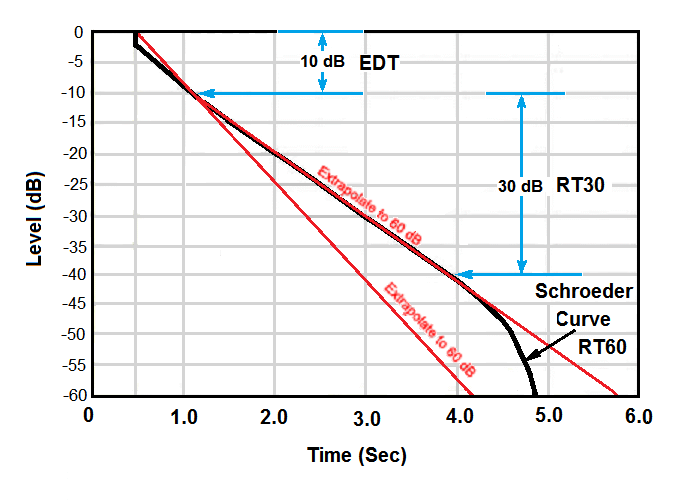
RT60, RT30, ECT
reverberation room – a large room with sound-reflective surfaces designed to produce a uniform, diffuse distribution of acoustic energy in random directions for use in acoustic research and design. These rooms usually use a broadband sound source, such as white noise or pink noise, so that the sound field contains acoustic energy across the whole audible spectrum. They are used for microphone calibration, measurement of the absorption coefficients of various materials, and other acoustic measuremensts. Also called a reverberation chamber.
reverberberation tail – see late reflections.
reverberation time – the amount of time (in seconds) it takes for a reverberation to decay to 60 dB below the original sound pressure level (SPL) after the original sound has stopped. It is designated as RT60, RT-60, or RT60. The decay rate depends on the amount of sound absorption in the room, the room geometry, and the frequency of the sound. Reverberation time, designated as T30, RT30, or RT30 is based on a straight line curve fit between the -5 dB and -35 dB points on the Schroeder curve, extrapolated to 60 dB to be consistent with the RT60. Early-decay time (EDT) is based on a straight-line curve fit between the 0 dB and -10 dB points on the Schroeder curve, also extrapolated to 60 dB of decay. A strong direct field produces an EDT that has a steeper slope than the RT30 curve, which is desirable for increased speech intelligibility and music clarity. Reverberation times vary with frequency as shown in the Table 1 below. Optimum reverberation times depend on the program material, as shown in Table 2. Called reverb time for short. See also Sabine formula, Fitzroy formula and Eyring formula.
| Table 1 Reverberation Times vs. Frequency | |
|---|---|
| Frequency (Hz) |
Reverberation Time (Sec) |
| 125 | 1.6-1.8 |
| 250 | 1.0-1.4 |
| 500 | 0.9-1.3 |
| 1,000 | 0.7-1.2 |
| 2,000 | 0.6-1.1 |
| 4,000 | 0.5-0.8 |
| 8,000 | 0.3-0.6 |
| Table 2 Optimum Reverberation Time (Sec) | ||||
|---|---|---|---|---|
| Room Volume | 1,000 m3 | 5,000 m3 | 10,000 m3 | 20,000 m3 |
| Organ Music | 1.8-2.8 | 1.9-2.9 | 2.1-3.1 | |
| Choral Music | 1.8-2.8 | 1.9-2.9 | 2.1-3.1 | |
| Classical Music | 1.5-1.8 | 1.6-2.0 | 1.8-2.2 | |
| Chamber Music | 1.1-1.5 | 1.2-1.7 | 1.3-1.8 | 1.4-2.0 |
| Opera | 1.1-1.5 | 1.2-1.7 | 1.3-1.8 | 1.4-2.0 |
| Amplified Music | 0.7-.09 | 0.9-1.1 | 1.0-1.2 | |
| Lecture Hall | 0.7-0.8 | 0.8-0.9 | 0.9-1.0 | |
| Movie Theater | 0.4-0.6 | 0.5-0.7 | 0.7-1.0 | 0.9-1.4 |
reverberation unit – a hardware or software device that simulates the reflections of sounds (reverberation). Originally, these units used analog means to create reverberation, but today digital technology is mostly used. Called a reverb unit for short.
reverberator – (1) Anything that reverberates or produces reverberation. (2) A reverberation unit.
reverb tail – see late reflections.
reverb tank – an electromechanical device consisting of a set of springs and associated electronics mounted in a metal box to create artificial reverberation (spring reverb). These units were developed originally in 1939 by Laurens Hammond for use in his organs, but Hammond began supplying them to Fender to be sold as a standalone unit beginning in 1961. In 1963, Fender began including them in their guitar amplifiers.
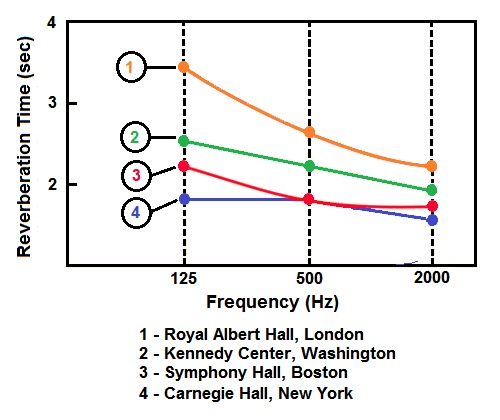
Source: hyperphysics.gsu.edu
reverb time – short for reverberation time.
reverb time contour – a graphical representation of reverberation time versus audio frequencies for a specific space. Also called a reverberation decay curve.
reverse bias – a bias voltage applied in the opposite direction of the current flow within a transistor, tube, or circuit, as opposed to a forward bias, which is a voltage applied in the same direction as the current.
reversed polarity – see polarity inversion.
reverse echo – a special effect in which an echo precedes the sound that caused it, increasing from silence into the original sound. This effect is created in the same way as preverb. Also called backwards echo or reverse regeneration.
reverse regeneration – see reverse echo.
reverse reverberation – an artificial digitally created effect in which reverberation increases instead of decaying.
rev/min – see rpm.
REW – Room EQ Wizard.
rewind – (1) To move a recording tape quickly from the take up reel to the supply reel. (2) Sometimes used in a digital audio workstation to describe moving an edit or play point to an earlier part of a digital audio track.
ReWire – a mechanism developed by Steinberg and Propellerhead that allows various audio applications to communicate and interact with one another using MIDI.
REX file – a proprietary audio file format for sample loops developed by Propellerhead. It is one of the most popular and widely-supported loop formats used in many sequencers and digital audio workstations. REX loops can be timestretched without disturbing the original sound. The REX name comes from ReCycle EXport because these files are generated by Propellerhead's ReCycle looping utility.
RF – Radio Frequency.
RF64 – a 64-bit multichannel wave file format for file sizes that exceed 4 GB, designed to meet the requirements for multichannel sound in broadcasting and audio archiving. It is BWF-compatible and is specified by the European Broadcasting Union (EBU). If the size of a file is less 4 GB, the output file will have a 32-bit RIFF wav format. If the file exceeds 4 GB, the output file automatically will have a 64-bit RF64 format. The format can contain a maximum of 18 surround channels, a stereo down-mix channel, and bit stream signals with non-PCM-coded data. RF64 can be used for the entire program chain including recording, editing, and playback, as well as for short- and long-term archiving of multichannel files. If an RF64 file has a bext chunk in the header, it becomes an MBWF (Multichannel Broadcast Wave Format) file. The terms RF64 and MBWF are often used interchangeably. RF64 files can use the file extensions .wav, .bwf, or .rf64.
.rf64 – one of the file extension used with RF64 files.
RF-biased condenser microphone – see RF condenser microphone.
RF condenser microphone – a type of condenser microphone that uses a relatively low radio frequency (RF) voltage generated by a low-noise oscillator instead of a dc polarizing voltage. (See RF principle.) Sound waves vibrate the capsule diaphragm causing changes to the capacitance. Demodulation produces a low-noise audio frequency signal with very low source impedance, which can be used to directly drive bipolar transistors without a transformer instead of FETs. RF condensers have several advantages. Without a high bias voltage, they can use a diaphragm with looser tension to achieve wider frequency response. An RF-biased capsule has a lower impedance capsule, so that an RF condenser microphone can be operated in damp weather conditions that may create problems for dc-biased microphones. (Moisture tends to siphon off the charge of the capacitor.) Since bipolar transistors produce less random noise than the FETs, equalization can be included in the microphone circuitry to increase the dynamic range and to produce a more linear multichannelfrequency response. A low frequency response can be achieved even with small capsules that usually is only possible with larger capsules. Sometimes called RF-biased condenser microphone or RF-modulated condenser microphone.
RFI – Radio Frequency Interference.
RF impedance – the effective resistance at the connection between the transmitter and the antenna, comparable to impedance in an ac circuit. For optimum performance, the input impedance should be properly matched. For wireless microphones, a value of 50 ohms is generally used.
RF microphone – see wireless microphone or RF condenser microphone.
RF-modulated condenser microphone – see RF condenser microphone.
RF principle – the principle of using the capsule of a condenser microphone as the tuning capacitor in a radio frequency (RF) circuit, operating in a low impedance mode with a high frequency (around 8 MHz) passing through the capacitor. Sound waves vibrate the diaphragm causing the capacitance to change, which modulates the tuning of the RF circuit proportional to the sound wave. A demodulator circuit converts the modulations into an audio signal.
RFZ – Reflection Free Zone.
RGB – Red-Green-Blue. The system used for representing the colors on a computer display. By combining red, green, and blue in various proportions just about any color in the visible spectrum can be displayed.
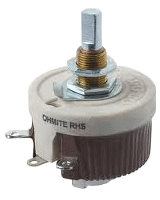
RGBHV – Red-Green-Blue-Horizontal-sync-Vertical sync. A five-wire cable carrying the red, green, and blue video signals, as well as the horizontal and vertical sync signals on separate conductors, used to connect the VGA output of a computer to the component video input of a monitor or video processor.
rheostat – an adjustable device used to control an electric current by varying the resistance, usually consisting of a coil of wire with a terminal at one end and a sliding contact that moves along the coil to tap off the current.
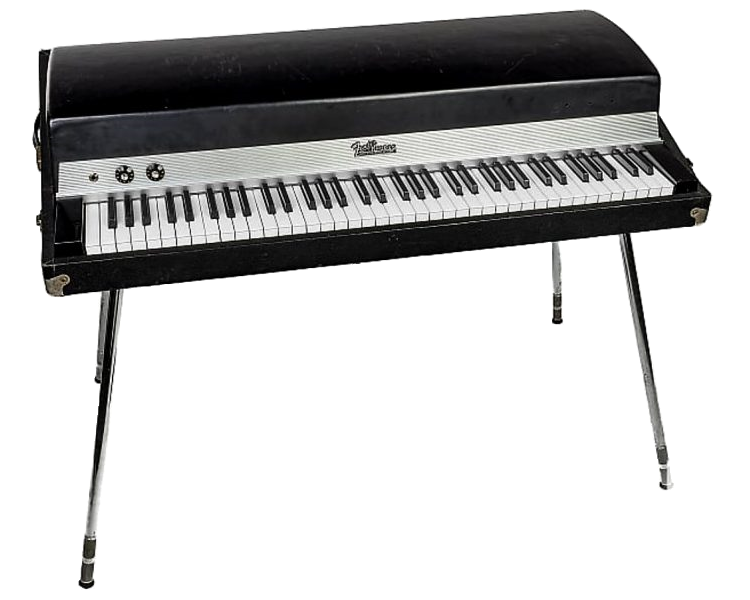
Rhodes piano – an electric piano invented by Harold Rhodes. Like a conventional piano, a Rhodes piano generates sound using keys and hammers, but instead of striking strings, the hammers strike thin metal tines, whose vibrations create a signal with an electromagnetic pickup. The signal is then fed to an external amplifier and speaker, similar to a guitar amplifier. The instrument evolved from Rhodes's attempt to create a more conveniently sized piano while teaching and entertaining wounded soldiers during World War II. After the war, Rhodes founded the Rhodes Piano Corporation and, in 1946, began producing the Rhodes Pre-Piano. In 1959, Rhodes formed a partnership with Leo Fender and began manufacturing the Fender Rhodes Piano Bass. CBS acquired Fender in 1965, and released the Fender Rhodes Mark I that year. It's popularity began to decrease in the 1980s due to competition from digital synthesizers and inconsistent quality control from CBS's cost cutting. Roland purchased the company in 1987. The instrument experienced a resurgence in popularity in the 1990s, and Rhodes was able to re-obtain the rights to the piano in 1997. Harold Rhodes died in 2000, but the Rhodes piano has since been reissued. Also called a Fender Rhodes piano.
rhythm – the combination and variation of beat, tempo, and meter that defines the character of a piece of music other than the melody.
rhythm guitar – a guitar that provides all or part of the rhythmic beat for singers or other instruments and/or provides all or part of the chords. Rhythm guitars are usually used with bands or groups playing within the acoustic, country, blues, rock, and other genres. The rhythm guitar is sometimes considered to be part of the rhythm section, along with the bass and drums.
rhythm instruments – see rhythm section.
rhythm section – (1) The instruments in a band or orchestra that establish the rhythm of a song rather than harmony or melody, such as drums, percussion, and bass. Also called rhythm instruments. (2) The group of players in a band or orchestra that play such instruments.
rhythm tracks – the tracks in a multitrack recording that contains the rhythm instruments, often recorded as the first thing in a session. Sometimes called band tracks or basic tracks.
RIAA – Recording Industry Association of America.
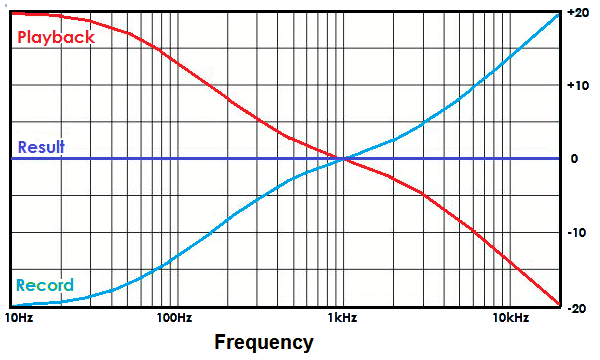
RIAA curve – an equalization curve established by the RIAA for use in the production of vinyl recordings to minimize surface noise. High frequencies are boosted and low frequencies are decreased during recording. The opposite takes place during playback. This minimizes noise and reduces sytlus travel for low freqencies. This process is called emphasis. The RIAA curve specifies three RC time constants (cutoff frequencies): (1) 3180 μs (50 Hz), (2) 318 μs (500 Hz), and (3) 75 μs (2120 Hz). Also called RIAA equalization or RIAA equalization curve. See also RIAA/IEC curve.
RIAA equalization – see RIAA curve.
RIAA equalization curve – see RIAA curve.
RIAA/IEC curve – an equalization curve similar to the RIAA curve, except it defines one additional time constant. The RIAA/IEC curve RC time constants (cutoff frequencies) are: (1) 7960 μs (20 Hz), (2) 3180 μs (50 Hz), (3) 318 μs (500 Hz), and (4) 75 μs (2120 Hz). Also called RIAA/IEC equalization or RIAA/IEC equalization curve.
RIAA/IEC equalization – see RIAA/IEC curve.
RIAA/IEC equalization curve – see RIAA/IEC curve.
RIAA input – see phono input.

RIAA Standard Reference Level – a signal level defined by the RIAA for vinyl records that corresponds to a peak stylus modulation (sideways) velocity of 5 cm/sec for a 1 kHz sine wave. All vinyl mastering studios calibrate their equipment to this level using test equipment and test recordings.
RIAJ – Recording Industry Association of Japan. An industry trade group of Japanese corporations involved the music industry. Founded in 1942 as the Japan Phonogram Record Cultural Association (JPRCA), it adopted its current name in 1969.
ribbon – (1) Another name for a ruler as used in a DAW. (2) The thin metal strip used in ribbon microphones and ribbon loudspeakers.
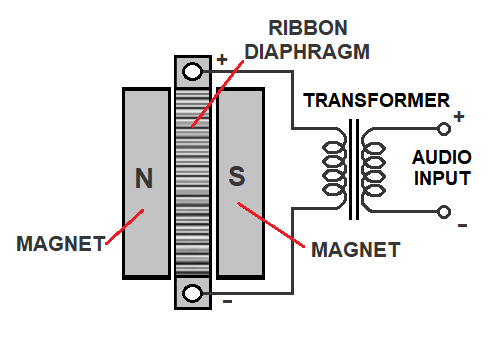
ribbon crimper – a device used to create corrugations in the metal ribbon as used in a ribbon microphone.
ribbon loudspeaker – a type of loudspeaker that consists of a very thin corrugated ribbon made of metal or metal-coated plastic, that is suspended in a magnetic field, similar to a ribbon microphone. An audio signal is applied to the ribbon, causing it to move producing sound. Because the ribbon has very little mass, it can accelerate very quickly, resulting in very good high-frequency response. However, they have poor low-frequency response, so they are most commonly used as tweeters. Ribbon drivers usually require very powerful magnets, which makes them more expensive. Because ribbons have a very low resistance that most amplifiers cannot drive directly, a step-down transformer is often used, which also adds to the cost. Ribbon speakers are typically very fragile and can easily be destoyed by a puff of air. Planar magnetic speakers are sometimes called ribbons, but they are not really ribbon speakers.
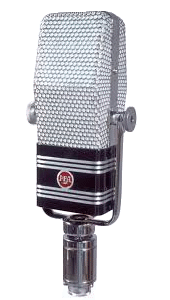
ribbon microphone – a type of dynamic microphone that uses a very thin corrugated ribbon made of metal or metal-coated plastic, that is suspended in a magnetic field. When sound waves cause the ribbon to vibrate, an electrical signal is created. Ribbon mics are usually more fragile than other designs, but are often chosen because of the warmth and smoothness they impart.
ribbon motor – the mechanism in a ribbon microphone that converts sound to an electrical signal, which includes the ribbon and magnet.
ribbon motor kit (RMK) – the parts to replace the motor in a ribbon microphone, either to replace it or upgrade it.
dome tweeter – see tweeter.
rich – (1) A descriptive term for a sound that has an even distribution of frequencies, especially the lower frequencies. See also full. (2) Having a special type of distortion made of even-order harmonics created by certain types of effects processors.
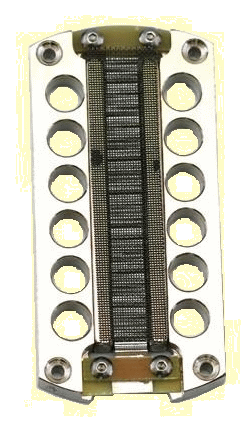
ride – see instrumental solo.
ride cymbal – a cymbal used to maintain a steady rhythmic pattern (a ride pattern), rather than an accent or crash.
ride pattern – see ride cymbal.
riding faders – manually adjusting the level during recording or mixing to bring up low sections and reduce loud sections of a performance. Also called riding gain, gain riding, or fader riding.
riding gain – see riding faders.
riff – a short musical phrase often played repetitively, typically played between vocal lines of a song. Also called a lick.
RIFF – Resource Interchange File Format. A format method for storing data in uncompressed WAV files on Windows computers. It is similar to the Audio Interchange File Format (AIFF) used on Apple Macintosh computers. The RIFF format acts as a wrapper for various audio coding formats, but the ususal bitstream encoding is the LPCM (linear pulse-code modulation) format.
rifle microphone – see shotgun microphone.
rights clearance – see music clearance.
rights holder – a person or legal entity that has exclusive rights to a protected copyright, trademark, or patent, including the related rights of producers, performers, and broadcasters. A rights holder may license all or a portion of a protected work in accordance with international legal and licensing laws, and they control the use of these exclusive rights, including reproduction and distribution, with certain limitations and exceptions. If a protected work is used without permission, the rights holder may pursue legal action against the unauthorized user. Sometimes called right holder.
rim – a wood or metal ring that holds the drumhead onto the drum shell and contains holes through which tension rods go and screw into the lugs, used to tighten and adjust the tension of the drumhead. Also called a counter hoop, drum hoop,, or hoop..
rimclick – see cross stick.

rim shot – a drumming technique when the drummer strikes the rim and the head of the drum at the same time. Sometimes spelled rimshot.
RIN – Recording Industry Notification. See DDEX.
ring connector – a round, flat connector with a hole through which a screw or bolt is inserted and tightened to make a connection. Compare with a spade connector. Also called ring terminal.
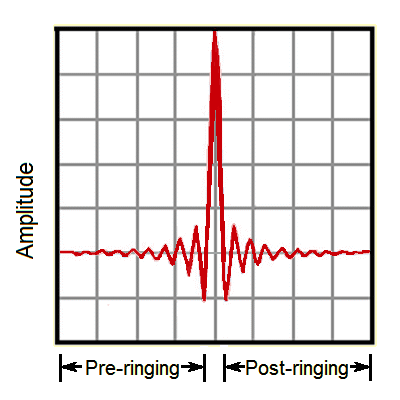
ringing – (1) The continuation of a signal or vibration after the input signal has stopped. Low frequency ringing is called hangover. (2) A type of distortion that occurs as spurious oscillating signals near transients. It is called “ringing” because the output signal oscillates and slowly fades near the transient, similar to a bell being struck. Pre-ringing (or pre-echoes) occur before a transient, a phenomenon that does not occur in nature. Post-ringing occurs after a transient. Minimization of such ringing artifacts is one criterion in filter design. With filters, the phenomenon is sometimes called ripple.
ringing out a room – the process of eliminating problem frequencies that are prone to cause feedback in a performance venue. One method involves sending pink noise through the speakers and then increasing the microphone levels until feedback occurs. Sometimes called tuning the system or tuning the room, although the latter term is technically incorrect.
ring modulation – a method of sound synthesis in which one signal is multiplied by another signal to create two new frequencies (tones) which are the sum and difference of the input frequencies. This produces a large number of harmonics. See also ring modulator.
ring modulator (RM) – a device used to create ring modulation. It is called a ring modulator because early RM circuits had a ring of diodes that changed the polarity of the carrier signal based on the polarity of the modulation signal.
Ringo Starr drum-miking technique – a two-microphone drum-miking technique that was used on most of the Beatles recordings. One microphone is placed about a foot or less from the front of the kick drum at about the height of the beater and aimed at the beater. The second is an overhead mic that is placed over the center of the kit just above the head of the drummer. This method was used for mono recordings, and both mics were usually recorded on a single track. This setup works best for small kits like those used in the 1960s.
ring terminal – see ring connector.
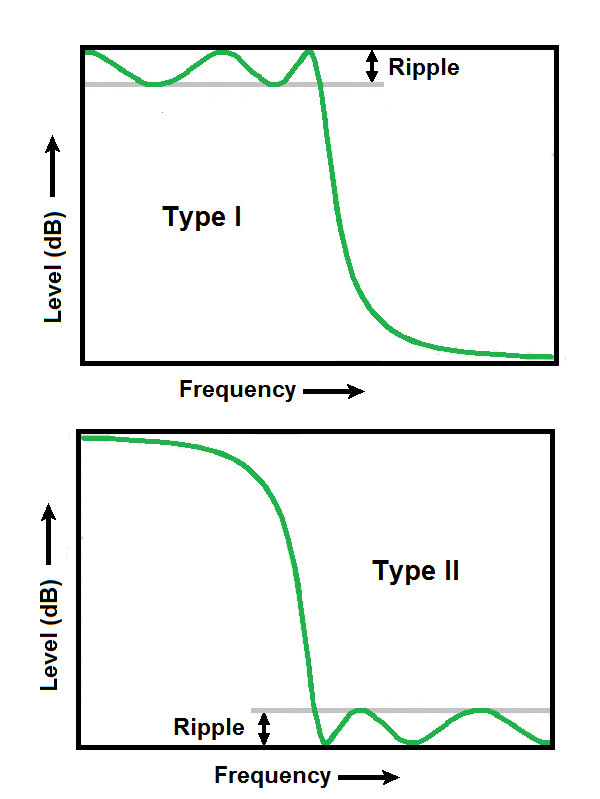
rip – to convert audio or video files from one format to another so that they can be stored in another medium, such as a converting a CD to an MP3 file. Also called grab or digital audio extraction (DAE).
ripple – (1) Irregularities in the frequency response of a filter that should be flat. Ripples in the passband are called passband ripples. Ripples in the stopband are called stopband ripples or sometimes out-of-band ripples. See also ringing. (2) Undulations in the voltage of a dc power supply.
ripple edit – a type of editing that occurs when a new clip is inserted, or an existing clip is deleted, the remaining material is adjusted to fit. The change ripples through the rest of the material as the remaining clips slide apart to make room for the new clip or slide together to fill a gap.
rise time – the time it takes for a signal to increase from one level to another, typically from 10% up to 90% of the maximum value. See also decay time.
ritardando – a musical term indicating that the tempo should be gradually decreased. The opposite of accelerando.

RJ11 – a standard 6-pin modular connection (plug and jack) using 2 wires primarily used to connect telephones, but also used in other electronic devices. See also registered jacks.
RJ12 – a standard 6-pin modular connection (plug and jack) using 6 wires primarily used to connect telephones, but also used in other electronic devices. See also registered jacks.
RJ45 – a standard 8-pin modular connection (plug and jack) using 8 wires primarily used for connecting Ethernet devices. See also registered jacks.
RMA – Radio Manufacturers Association. See Electronic Industries Alliance.
RMCS – Remote Music Collaboration Software.
RME Audio – a professional audio company founded in 1996 and headquartered in Haimhausen, Germany. It designs and builds audio hardware, such as audio interfaces, analog-to-digital converters, and digital-to-analog converters.
r/min or r-min‑1 – see rpm.
RMM – Recreational Music Making. Making music for the fun of it.
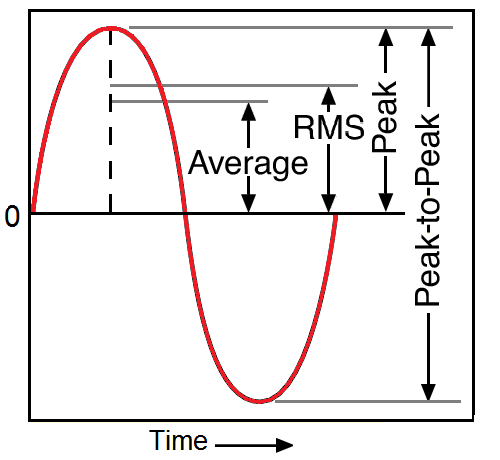
Average, and Peak Level
RMS – Root Mean Square. A method of computing an average value by taking the square root of the average of the squares of all the instantaneous values of a signal. It is sometimes called the effective value. Compare with peak value and peak to peak.
RMS meter – a type of sound level meter that visually indicates the RMS of the audio level of a signal. An RMS meter tends to indicate the average audio level, which is more indicative of the loudness of the signal than a peak meter, which is more useful for detecting clipping. Sometimes called an average meter.
RMS voltage – see Vrms.
RMU – Dolby Rendering and Mastering Unit.
RO – Resistive Opto-isolator.
Robert Bosch GmbH – a company founded by Robert Bosch in Stuttgart, Germany, in 1886. It is now a multinational engineering, automovtive, and electronics company headquartered in Gerlingen, near Stuttgart, Germany. In 2006, Telex/Electro-Voice was acquired by the Bosch Group and became Bosch Communications Systems.
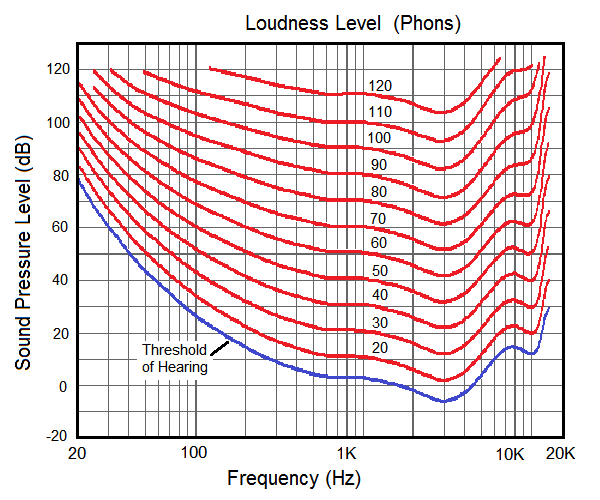
Robinson-Dadson curves – curves that show loudness as perceived by the human ear for various sound levels and frequencies. These equal loudness curves were developed using subjects in an anechoic room. The Fletcher-Munson curves were developed using subjects with headphones. Equal loudness curves are also called equal loudness contours, phon lines, or isophones.
robo – short for robotic camera. See pan-pilt-zoom camera (PTZ).
Rochelle salt – a crystalline solid made of sodium potassium tartrate tetrahydrate that has a large piezoelectric effect. This effect is beneficial for use in sensitive acoustical and vibrational devices and in electromechanical transducers, such as microphones and phonograph pickups. See also crystal.
rock 'n' roll – a type of popular dance music that originated in the 1950s, typically consisting of a heavy beat, basic melodies, simple chord progressions, and played with guitar, bass, and drums. Rock 'n' roll was a fusion of black rhythm and blues and white country music. The words “rock” and “roll,” which were black slang for sexual intercourse, were first recorded on a record in 1922 with Trixie Smith's “My Man Rocks Me (With One Steady Roll).” Although often credited with doind so, Alan Freed did not coin the phrase rock 'n' roll, he was just the first to apply it to the new genre of music. Sometimes spelled rock and roll. Called rock for short.
RØDE Microphones – an Australian-based designer and manufacturer of microphones, a subsidiary of Freedman Electronics Group, established in Sydney in 1967 by the husband-and-wife team of Henry and Astrid Freedman. In the early 1990s Peter Freedman took over the family business, which had fallen on hard times, and began importing Chinese microphones, which he repaired and modified. Sales took off like “a rat up a drain pipe,” which led to the unofficial nickname for his microphone as the “Rodent-1.” They morphed that name into the RODE NT-1. Freedman replaced the “O” with the “Ø” character in recognition of his Scandinavian heritage creating the new company name RØDE. (In Danish and Norwegian røde is the plural of rød which means red.) He soon moved the manufacturing to Australia, which greatly helped to improve product quality, and made RØDE a subsidiary of Freedman.

RØDE NT1 – a cardioid condenser microphone introduced by RØDE in the early 1990s, as a great-sounding and very affordable microphone. (See history above for how the name and microphone came into being.) When they moved production from China to Australia, it was released as the RØDE NT2. In 1995, it was redesigned and a number of improvements made and released as the NT1A. Over the years, a number of improvements have been made with the fifth generation being released in 2023 with both XLR and USB outputs. The NT1 Signature Series was released in 2024, without the USB output, but available in choice of six colors: red, green, purple, pink, blue, and black. It comes with a high-quality shock mount with a pop filter that attaches directly to the mount.
RoHS – Restriction of Hazardous Substances Directive, short for Directive on the restriction of the use of certain hazardous substances in electrical and electronic equipment. A directive adopted in February 2003 by the European Union that became effective on July 1, 2006, (made law and required to be enforced in each member state) that restricts the use of six hazardous materials in the manufacture of certain electronic and electrical equipment, with some exceptions. Four additional materials were added in 2015. The list includes lead, mercury. cadmium, hexavalent chromium (Cr+6), polybrominated biphenyls (PBB), polybrominated diphenyl ether (PBDE), bis(2-ethylhexyl) phthalate (DEHP), butyl benzyl phthalate (BBP), dibutyl phthalate (DBP), and diisobutyl phthalate (DIBP). One detrimental side effect has been that the use of lead-free solder has led to the premature demise of some electronic devices.
Roland Corporation – Rorando Kabushiki Kaisha. A company founded in Osaka, Japan, in 1972, that manufactures and markets synthesizers, electronic keyboards, drum machines, guitars, recording equipment, and software. Its headquarters were relocated to Hamamatsu in 2005. In 2014, Roland Corporation was bought out by Roland's then CEO, Junichi Miki.
Roland TB-303 Bass Line – a bass synthesizer with built-in sequencer manufactured by the Roland Corporation from 1982 to 1984. It was instrumental in the development of contemporary electronic dance music.
Roland TR-808 Rhythm Composer – a programmable drum machine, introduced by the Roland Corporation in 1980. TR stood for Transistor Rhythm. Like most early drum machines, it did not sound exactly like real drums, but it was one of the earliest affordable drum machines costing much less than the digital samplers available at the time. TR-808s frequently were used by recording studios in the 1980s to provide rhythms to be used on demos for musicians. Called 808 for short.
Roland TR-909 Rhythm Composer – a programmable partially analog, partially sample-based drum machine, introduced by the Roland Corporation in 1984, a succssor to the TR-808. TR stood for Transistor Rhythm. With a 16-step sequencer and a drum kit, it was designed for realism and cost-effectiveness. It was the first MIDI-equipped drum machine. Called 909 for short.
rolloff – (1) The attenuated portion of a signal affected by a rolloff filter. (2) Short for rolloff slope. (3) The point at which the frequency response of a speaker begins to decrease. Also spelled less correctly as roll off or roll-off.
rolloff filter – (1) A filter that reduces the output as the frequency increases. (2) A circuit that attenuates a signal that is above (lowpass) or below (highpass) a specified frequency. Also spelled as the less-preferred roll off filter.
rolloff frequency – see cutoff frequency.
rolloff rate – see cutoff rate.
rolloff slope – see cutoff rate.
Roman numeral analysis – using Roman numerals to represent chords, where Roman numerals (I, II, III, IV, ...) indicate the scale degree (first, second, third, fourth, ...) of the root note of the chord. For example, V is used to indicate the chord based on the fifth degree of a scale. Usually, uppercase Roman numerals, such as I, IV, and V, represent major chords while lowercase Roman numerals, such as i, iv, and v, represent minor chords. The use of Roman numerals allow musicians to quickly determine the progression of chords in a song. Because Roman numeral designations are independent of the key, chord progressions can be transposed easily to any key. For example, the standard twelve bar blues progression is indicated by the Roman numerals I, IV, and V, although it is sometimes written I7, IV7, and V7, because the blues progression is often based on dominant seventh chords. In the key of C, the chords would be C7, F7, and G7. The same progression in the key of A would be A7, D7, and E7. In addition to using a superscript 7 to indicate seventh chords, a superscript o is used to indicate diminished triads and a superscript + is used for augmented triads. In some notations, all roman numerals are in caps, but minor chords are indicated by a lower case m. Other symbols are sometimes used for other types of chords. Also called Roman numeral notation. See also Nashville Number System.
room acoustics – the manner in which sound behaves in an enclosed space. See also acoustics and architectural acoustics.
room acoustics modelling< – see room acoustics simulation.
room acoustics simulation – software that attempts to replicate the acoustic behaviour of sound within a given enclosed space. Also called room simulation, room acoustics modelling, and acoustics modelling.
room compensation – see room equalization.
room correction – see room equalization.
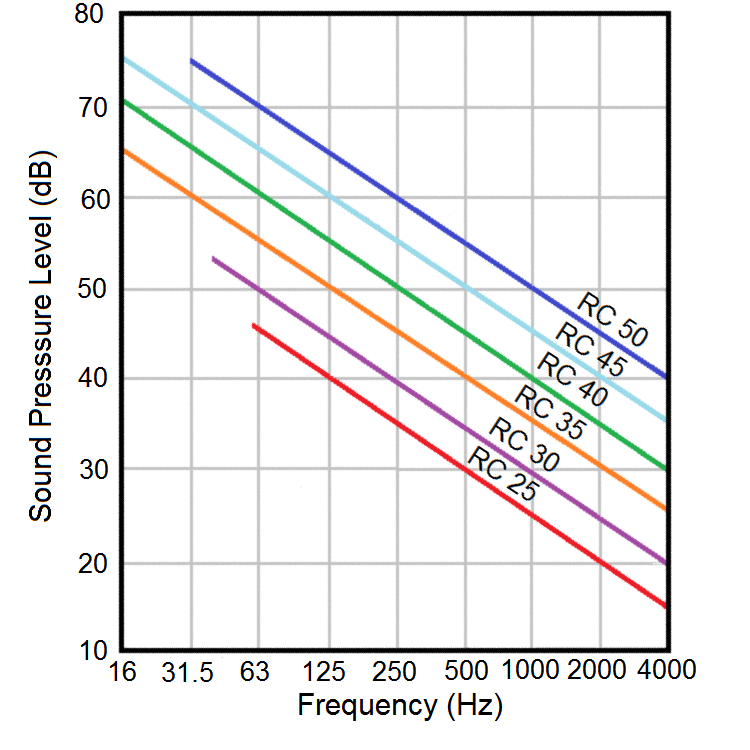
room criteria (RC) – a system used for rating background noise in a building, measruig sound pressure levels (SPL) over the frequency range of 16 Hz to 4000 Hz. This system uses a two-step process: (a) determining the mid-frequency average level and (b) determining the perceived balance between high and low frequency sound. See also noise criteria (NC), noise rating (NR), and balanced noise criteria (NCB).
room equalization – the modification of the frequency response of signals sent to monitors to compensate for the acoustics of the room. Sometimes called dereverberation, room correction or room compensation. When it is done using software, it is sometimes called digital room correction. See also room mode and Room EQ Wizard.
Room EQ Wizard (REW) – a free software program for the analysis of room acoustics designed to measure and analyze room and loudspeaker responses. It was developed to help optimize the acoustics of recording studios, listening rooms, and home theaters, and to find the best locations for monitors, speakers, and subwoofers, as well as to determine the best listening position.
room-in-room effect – the effect that occurs when sound is played back through loudspeakers that includes the reverberation that occurred during recording as well that reverberation that occurs in the playback room.
room microphone – a microphone set up at some distance from a sound source to capture the natural ambience of the room. Sometimes called an ambient microphone
room miking – the process of setting up a room microphone at some distance from a sound source to capture the natural ambience of the room. Sometimes called an ambient miking
room modes – the resonant frequencies that occur in a room caused by standing waves that make certain frequencies, mainly in the range of 20 Hz to 200 Hz, sound louder than others. These frequencies are related to one or more of the dimensions of the room or a divisor of those dimensions. Room modes occur in three types: (a) axial mode – along the axes of a room (front to back, side to side, floor to ceiling), (b) tangential mode – any two pairs of opposite surfaces, and (c) oblique mode – the product of the reflections of all six surfaces. Also called eigentones, standing wave frequencies, room resonances, or modes for short. See also frequency zones.
room ratios (RR) – the ratios of the dimensions of rectangular rooms that create the fewest problems (most uniform distribution) of low-frequency room modes. There is no standard agreement as to what these ratios should be. Some people say that a ratio of height to width to length of 1:1.6:2.6 is considered to have “perfect” acoustics. (Sound engineers frequently use the ratio of 0.62:1:1.62.) It is claimed that no matter where you stand in such a room, the sound will be balanced and natural, and there is little interference from standing waves and essentially no ringing. Researchers on this topic included L. Louden, L. W. Sepmeyer, Philip M. Morse, and Richard H. Bolt. In 1965 Sepmeyer published three sets of ratios: (a) 1:1.14:1.39, (b) 1:1.28:1.54, and (c) 1:1.6:2.33. In 1971, Louden published several ratios, the most often used was 1:1.4:1.9. See also the golden ratio.
room resonances – see room modes.
room reverb – a reverberation effect that simulates the reverb typical of a smaller acoustic space. Room reverbs provide a natural color and liveliness to a track. Room reverbs acan be used with just about anything—vocals, guitars, pianos, drums. They can add space while maintaining an intimate, in-person character.
room simulation< – see room acoustics simulation.
room sound – the characteristic ambient sound of a space including reverberation and background noise.
room tone – the ambient noise in a space without any sound being generated.
room transition frequency – see Schroeder frequency.
room-within-a-room – a method of soundproofing a recording studio by using double-layer walls with dead space and insulation between the two walls. See also floating floor.
root – the lowest note of a chord, which usually gives the chord its name. For example, C is the root of the chord of C (C, E, and G). If the root is not the lowest note, the triad is said to be inverted. See also tonic.
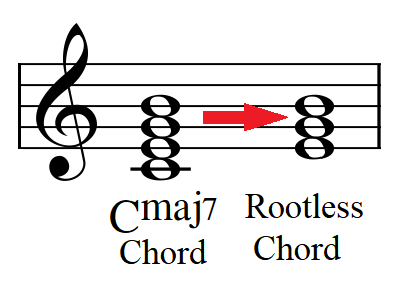
rootless chord voicing – a chord played without the root note. A rootless chord is sometimes used in jazz, where the the root note is often played by the bass player.
root mean square – see RMS.
rotary encoder – a device that converts rotation or movement around a shaft into digital code, such as pan or EQ adjustments. There two types of rotary encoders: absolute and incremental (relative). The output of an absolute encoder is indicated by the position of the shaft. The output of an incremental encoder is indicated by the change in position around the shaft. Also called a shaft encoder.
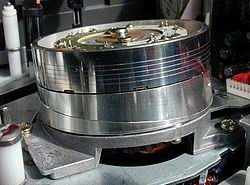
rotary equalizer – a multiband equalizer that uses rotary controls for adjusting the parameters.
rotary head – the head on a rotating drum of a video recorder or DAT recorder that sweeps across magnetic recording tape at a slight angle, which a high rate of scanning at a low tape speed. Sometimes called a rotating head.
rotary speaker – see Leslie loudspeaker.
rotating head – see rotary head.
rotational speed – the speed at which an object rotates around it axis per unit time, usually specified as revolutions per minute (rpm) or revolutions per second (rps). Also called speed of revolution. See also angular frequency and angular velocity.
rotation point – the point in a compressor or expander above or below which the output signal level is affected.
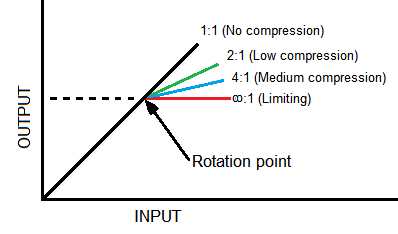
rotation rate – see rotational speed.
rough mix – a mix made at an intermediate stage of the mixdown process, often for evaluation or audition purposes.
roughs – a collection of recorded tracks that have not been mixed or have only been partially mixed.
round – a descriptive term for a balanced sound, having a pleasing balance of low- and high frequencies. Somestimes called rounded.
routing – (1) The process of sending an audio signal from one point to another. (2) The path in which an audio signal flows through a device, such as a console or DAW.
royalty – money paid to composers for each public performance of a musical work, to authors for each copy of a book sold, or to patent holders for the use of a patent.
royalty-free – the right to use copyrighted works or intellectual property without being required to pay royalties or license fees. Some restrictions usually remain, such as not being able to resell.
Royer Labs – a microphone company headquartered in Burbank, California, that was founded in 1998 by microphone designer David Royer along with John Jennings, Rick Perrotta, and Rafael Villafane. It primarily designs and manufactures ribbon microphones. At the time most ribbon microphone designs were decades old, very fragile, with low outputs. Royer created new designs for ribbon mics using newer, more powerful neodymium magnets, improved transformers, and new ribbon corrugation techniques. David Royer also designs condenser microphones for their sister company, Mojave Audio.
RPG – see reflection phase grating or RPG Diffusor Systems, Inc..
RPG Diffusor Systems, Inc. – a company founded in the early 1980s by Peter D'Antonio, that designs and manufactures acoustic products. It is located in Upper Marlboro, MD.
rpm – Revolutions per Minute. The measure of the frequency of a rotation or the number of turns completed in one minute around a fixed axis. It is used as a measure of rotational speed of things such as records, hard disks, and compact discs. Records generally have rotational speeds of 78, 45, or 33⅓-rpm. It is also indicated as RPM, rev/min, r/min, or r-min‑1), with r/min being the recommended symbol, but is rarely used outside scientific writings.
RS – Recommended Standard. A series of standards issued by the EIA, such as RS-232, the standard for a serial interface.
RS-232 – the recommended standard for a serial interface.
RSSI – Received Signal Strength Indicator. A meter or display showing the strength of a radio signal as picked up by a receiver.
RT, RT-60, or RT60 – see reverberation time.
RTA – Real-Time Analyzer.
RTAS – Real Time AudioSuite™. The plug-in format used by Avid for Pro Tools 9 and earlier. RTAS uses the host computer for processing in real time whereas TDM uses dedicated DSP on hardware cards for processing. Both RTAS and TDM were replaced by AAX with Pro Tools 10 and above.
RTFM – slang abbreviation for Read The F**king Manual, often used on user forums as a derogatory response to someone asking how to perform a task that is plainly in the user manual. However, they seldom mention that the manual is hundreds of pages or what to search for in the manual.
RTMA – Radio Television Manufacturers Association. See Electronic Industries Alliance.
RTSP – Real-Time Streaming Protocol. A method of transmitting high-quality audio over the internet, used for sending live concerts and for other professional audio applications.
RTZ – Return To Zero.
RU – see rack unit.
rub and buzz – a slang term for manufacturing defects that create noises caused by rubbing and buzzing or due to loose particles, especially in loudspeakers.
rubato – (1) In music, having the expressive and rhythmic freedom to slightly speed up and slow down the tempo of a section of music at the discretion of the performer. Sometimes called tempo rubato. (2) A rubato phrase or passage. (3) A rubato performance.
rudiment – see drum rudiment.
rule of three – see 3-to-1 rule.
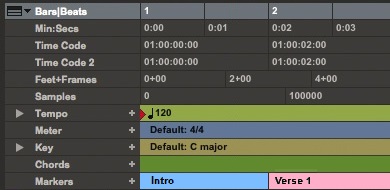
ruler – a ribbon that usually runs across the top of a DAW that displays a variety of information. The number of rulers and the content vary with the DAW. For example, there are two categories of rulers in Pro Tools: timebase and conductor. Timebase rulers provide the timeline in several different formats: (a) minutes and seconds [called a time display ruler in some DAWs], (b) bars and beats for music [called a bar ruler in some DAWs], (c) SMPTE timecode in H:M:S:F for video [called a SMPTE ruler by some], and (d) feet and frames for film. Timebase rulers can be sample-based time (absolute time) or tick-based time (relative time). For example, the minutes:seconds ruler measures absolute time, while the Bars|Beats ruler measures relative time. Conductor rulers display a variety of information that can affect or control the timebase. The meter ruler indicates the number of beats in a bar, while the tempo ruler indicates the number of beats per minute, as well as any changes in meter and tempo within the session. Tempo and meter events affect the timing of tick-based tracks and provide the tempo and meter map for the bar and beat grid and the click track. The key signature ruler indicates changes in key, which will affect MIDI notes when transposing. The chord symbols ruler indicates chords. The marker ruler shows memory locations (markers) and sections of the song. Also called bands or ribbons in some DAWs.
rumble – (1) A low-frequency noise caused by the mechanical vibration of equipment such as a turntable or tape transport. (2) A low-frequency noise caused by exterior sounds such traffic and air conditioning.
run down – see run through.
running master – see print master.
running sheet – see run sheet.
run off – a quick mix usually recorded on a compact disc (previously on a cassette) for the client to listen to the results of a recording session.
run-off groove area – see run-out groove area.
run-out groove area – the area between the last cut or track on a vinyl phonograph record and the label, where the groove is spaced farther apart and the ceases to advance toward the center of the record. Also called run-off groove area, end-groove area, matrix area, or dead wax (slang).
run sheet – a sequential list of scenes, events, and actions used in stage, film, video, television, radio, and audio. The run sheet breaks the program into time segments and lists actions, start and stop times, audio cues, camera directions, etc. During production run sheets are provided to the stage crew, camera crew, and audio crew for cues and references. Also called a running sheet or show sheet.
run through – playing a song before recording starts in order for the engineer to set levels and check sound quality. Also called a run down.
Rupert Neve Designs, LLC – a company founded by Rupert Neve and headquartered in Wimberley, Texas, that designs and builds high-end audio equipment for the recording studio. It began in 1975 in the UK as ARN Consultants when Neve left Neve Electronics. In 1994, Neve moved to Wimberley, Texas, and in 2002, the company became a US corporation, ARN Consultants, LLC. In 2005, it changed its name to Rupert Neve Designs, LLC.
rushes – see dailies.
rustle track – the audio track that contains the Foley sound effects. This term is used on east coast. On the west coast, it is called a cloth track. These names are derived from the rustling of clothing.
rute – a beater for drums, usually made of a bundle of thin canes, twigs, or wooden dowels attached to a handle. Some have a band that can be moved to adjust the tension on the bundle, in order to alter the tone produced by the rute. It is used to play various drums, including the snare and bass drum. It is pronounced “root-uh.” Also spelled ruthe, which is German for “rod.” Also called a rute stick.
rute stick – see rute.
RX – one of several abbreviations for receive.
Note: We believe this is the largest dictionary (glossary) of terms specific to usage within the recording industry that is currently available on the internet, with more than 8,800 entries, nearly 800 illustrations, and dozens of tables. Some of the terms have different or additional meanings in other situations, especially within the electronic, automotive, scientific, and computer industries. Of necessity there are obvious overlaps into other fields such as music, electronics, and computers, but such excursions are limited to information deemed pertinent to the knowledge required to operate and/or participate effectively in the workings of a recording studio. Also included are terms related to sound reinforcement (live performances) including wireless microphone technology because a working knowledge of that terminology is necessary for recording at live performance venues. Because recording studios also record audio for video and motion pictures (films), some terminology from those fields is included. Some scientific terms are included because they help explain studio terminology. For example, electromagnetism explains how microphones, loudspeakers, and guitar pickups work. Knowledge of radio waves and the radio frequency spectrum is needed to explain wireless devices. Any trademarks or trade names mentioned belong to their respective owners. The information contained in this dictionary is believed to be accurate at the time of publication. This information is subject to change without notice. The information was obtained from and cross-checked with a variety of sources that are believed to be reliable. However, Los Senderos Studio, LLC does not guarantee the accuracy or completeness of the information contained herein. Please contact us to report any errors, omissions, discrepancies, or broken links. Los Senderos Studio shall not be responsible for any consequences or damages arising out of the use of this information. Nothing in this glossary should be interpreted as legal advice. For a glossary providing information on legal and business matters for musicians, we suggest you consult Musicians Business Dictionary.
A note on alphabetical order: The terms in this glossary are alphabetical without regard to spaces and punctuation. For example, AM Radio follows amplitude. While this may seem to be at odds with other conventions, it eliminates confusion with words such as pickup, which is sometimes written as pick up or pick-up. In addition, all symbols such as &, -, or / are ignored. The entries on the number page (0-9) are listed in increasing value within each digit. For example, all of the entries beginning with 1 are listed before those starting with 2. For Greek letters (α-ω), the entries are in Greek alphabetical order.


